In John Niven’s latest novel, The Fathers, first-time dad, Dan, meets Jada, father-of-six. They both represent very different sides of the city of Glasgow, and, in meeting each other, these two sides collide in a devastating way.
The Fathers
By John Niven
Published by Canongate
They were going the same way, Dan realised. It was freezing. ‘Look, uh, I’m really sorry,’ he said. ‘I’ve forgotten your name.’
‘Jada.’
‘Jada, aye. Look, uh, do you want a lift? I’m going that way.’
A moment. Jada considering. ‘Ye sure?’
Dark, wintry Govan slid silently by. It was trying to snow again, tiny flecks blowing through the orange balls cast by the streetlamps, the interior of the car softly lit by the computer screen set in the dash.
Jada looked around, appraising. ‘Tesla, eh?’
‘Yeah, I know,’ Dan said, shaking his head. He’d been touched by the way Jada had watched him start the car, fascinated by the keyless procedure, the car unlocking simply by responding to Dan’s phone as they approached it, then the tapping of the four-digit code into the touchscreen. ‘I keep thinking we should sell it. At this point it’s like driving a MAGA cap on wheels, right?’
Jada looked at him as if he’d said ‘Bumbellybuttonfeet’.
‘But,’ Dan went on, ‘it just drives so well.’
‘Aye. They’re hard to fucking’ – Jada just stopped himself saying ‘steal’ – ‘beat. Hard to fucking beat.’
A whumf as they entered the Clyde Tunnel, the light bright, flooding the car. Dan noticed the frayed cuffs of Jada’s grey jogging bottoms, the thin hoodie he was wearing. Had to be minus 3 out. ‘So, Jada, you got any tips for me?’
‘Tips? The horses, like?’
‘No, no – fatherhood. It’s not your first rodeo, you said, eh?’
‘Right. Tips, wi’ the weans?’ Jada thought, What the fuck? ‘Er, well, Ah’m maybe no the best person to ask, like, Dan. I’m kinda old school, know what Ah mean? Like, hands-aff type? Jist let them fucking get oan wi’ it. Wipe their ain arses as soon as they’re old enough?’
‘Right, right,’ Dan said. ‘Wipe their own arses.’ He repeated this as though it was a maxim handed down from Dr Benjamin Spock himself.
Silence. After a moment Jada coughed and broke it. ‘So where do you live yourself, Dan?’
‘Hyndland.’
‘Oh aye. I’ve a couple o’ mates up there. Whereabouts?’
‘Park Crescent?’
‘Aye? Nice. Very nice. Obviously daeing well for yersel, living up there and driving a motor like this. Whit kinda business ye in, Dan, if ye don’t mind me asking, like?’
Here we go, Dan thought. Very often, when this came up in casual conversation, with the cab driver, the barman, he would lie. Go generic. ‘Computers,’ he’d say. Or ‘management’. For whatever reason – tiredness, an urge to impress – he decided to be straight with Jada. ‘Well, you know McCallister? The detective show?’
‘Aye. Course.’
‘I write it.’ He’d never say, ‘I created it.’ Too pompous.
Jada’s eyes going sideways to look at him. Then, ‘Away tae fuck.’ Jada said this simply and without malice.
‘I do. Swear to God,’ Dan laughed.
‘Is that right?’ Jada looked at him with fresh interest.
‘Yep. Twenty bloody years now.’
A silence as Jada absorbed this news. ‘So dae ye write, like, the stories? Aw whit they’re gaunnae dae and that?’
‘Yeah. And the dialogue.’ Another ‘bumbellybuttonfeet’ look from Jada. ‘You know, the words they say.’
‘Aye?’ Jada said. ‘Somebody writes aw that?’
‘Yeah.’
‘Ah always thought they actors just made it up as they went along.’
‘Ah, no, not usually.’ Though who could forget Gregor’s passion for improvisation in the early days?
‘And ye get good money for that, aye?’
‘Yeah, it’s not bad.’
‘Go oan yersel, pal.’
A sonic pop, the ambient noise changing as they emerged from the tunnel and out into Whiteinch. They passed Victoria Park on their left, and Jada fleetingly remembered taking Big Sonia McPherson from behind in some bushes in there in his late teens. There was also the time over by the pond when him and Panda had taken on five of the Scotstoun Young Team and leathered the fucking lot of them. Jada’s personal topography of Glasgow was overlaid with a grid referencing many, many fucks and fights. ‘And what line of work are you in yourself, Jada?’ Dan was asking now, the name still feeling ludicrous in his mouth.
‘Ach, a bit o’ this, bit o’ that,’ Jada said. ‘Here, whit’s yer man like?’
‘Sorry?’
‘Yer man that’s McCallister?’
‘Gregor?’ Fuck. Still had to call him back. Do it after he dropped Jada. ‘Oh, nice guy.’ Dan’s standard answer.
‘Aye? Ah heard he was a total fud, like.’
‘Really?’ Dan’s interest perked up at this. It was always pleasing to come across stray stories of Gregor behaving badly.
‘Aye. My pal Hughie, right, his brother’s pal’s oan the taxis and he said he hud him in his motor wan time, in fae the airport, and he said he was aw pure up himself.’
‘Is that right?’
‘Aye. Fucked him oan the tip an aw.’
‘Mmm-hmm. I’ll have to pull him up on that.’
‘Are youse pals, like?’
‘More colleagues.’
‘Oh aye. So he is a total fud, then?’
Dan laughed. They were coming along Dumbarton Road now, heading east. ‘Just up here’s fine, cheers, wee man. Appreciate it.’ Dan pulled over, up on the pavement in front of a row of shops. ‘Who ye aw meeting in Tennent’s, then?’
‘Oh, just some pals. Boys I went to uni with.’ Dan extended his hand. ‘Well, good luck with the wee one. When are you getting him home?’
‘Ach, doctor says it’ll be a few days yet. Nicola’s still bad wi’ the high blood pressure an aw that. Jist couldnae get aff the fags. She cut doon, so she did. But it’s hard, eh.’
‘Uh, yeah.’ Jesus.
‘When’s your boy getting oot?’
Made it sound like prison. ‘Tomorrow morning.’
‘Right, well, see ye roon then, Dan.’
‘Yeah. Sure. Take care, Jada.’
The heavy clunk of the door.
Dan drove off, casting a glance in the rear-view mirror, seeing the tall, slim figure hurrying across the road, dodging cars, towards the light of some dismal pub. And Dan Chambers thought all the usual things someone of his education, income and class would think.
Six kids from six women.
Smoking while she’s pregnant.
Jesus – what chance did that poor kid have in life?
But he also thought it must be liberating to some degree.
The pleasures of the unexamined life and all that. Dan had read somewhere that the lower classes – as a good socialist he hesitated to even think in these terms – and the upper classes had all the fun. All the fucking and fighting without a care in the world and never a worry about money because there was a surfeit of it in one case and none of it at all in the other. Father a bunch of illegitimate kids? Fuck it, someone will sort it out, either the state or the centuries-deep pockets of your family. Yes, it must be nice, freeing, to not be poleaxed by all the usual middle-class handicaps and foibles.
Jada, in his turn, lit a Piccadilly in front of the Flaps, the tiny crystals of snow stinging as they landed on his face and forehead, and drew heavily on the rough fag as he watched Dan’s tail-lights disappear towards Byres Road and made his own judgements and calculations . . .
Park Crescent
LD70 KVH
3376
He dialled Tony. ‘Tony? Wee job fur ye the night.’ Jada listened, letting Tony say his piece, his ‘fuck sake’s and his ‘it’s freezing’s and whatever. Then he retorted: ‘Listen, ya wee ginger prick. Ah don’t gie a fuck if it’s fucking snowing. Get yer arse oot o’ that bed and do as yer telt. There’s fifty bar in it fur ye. Another hunner if ye get it done . . . Aye, thought that’d get ye moving. Meet me in the Flaps. Soon as.’
Jada hung up and pushed through the doors into the warmth of the pub.
The Fathers by John Niven is published by Canongate, priced £18.99.
Whether you’re packing your suitcase with a polka dot bikini, a pair of sturdy boots, or pack of playing cards, you must also remember to pack a book or two (or five!). Here are some suggestions across a whole lotta genres, that are just out, or coming out over the summer months. Enjoy!
Where better to start than at the seaside!
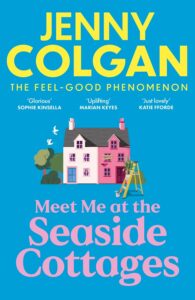 Meet Me at the Seaside Cottages
Meet Me at the Seaside Cottages
By Jenny Colgan
Romance
When 30-year-old Essie Carter moves back in with her mum in the seaside town of Carso, she’s leaving behind both personal and professional disappointments. Her mum, Janey, has a lot to be grateful for, but her confidence is shaken after the end of her marriage.
Scotland’s queen of feel-good romance is back with a mother-daughter tale of thwarted dreams, second chances, good friends & neighbours, rescue dogs, pub quizzes and house renovations.
We carry on with the feel-good stories with a novel described as ‘Normal People with pensioners.’!
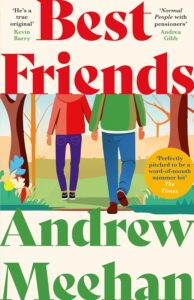 Best Friends
Best Friends
By Andrew Meehan
Romance
June is a cleaner; Ray is a janitor. Both have had their ups and downs (mostly downs) when it comes to relationships. However, a tentative friendship starts and grows between them and brings them the joy they have always missed.
Andrew Meehan’s novel has been gathering plaudits from critics and fellow writers and is becoming a bit of a word-of-mouth hit with readers!
If you love the classic enemies-to-lovers romance trope, then we recommend . . .
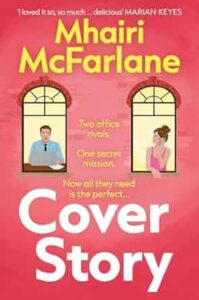 Cover Story
Cover Story
By Mhairi McFarlane
Romance
Bel and Connor are new starts in the tiny Manchester office of a national newspaper. Headline? They both have a lot to prove and they can’t stand each other. But when they’re thrown together as a loving couple in Bel’s latest undercover operation, sparks fly.
Mhairi McFarlane is back with another sharp, witty rom-com, and her fans include Marian Keyes, Holly Bourne and Jojo Moyes.
And when you can’t decide on a genre for your holiday reading, there’s always a short story collection that includes them all!
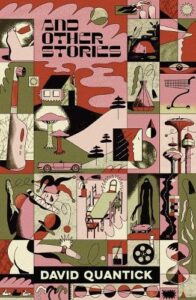 And Other Stories
And Other Stories
By David Quantick
Short stories
Short ones and odd ones, long ones and scary ones, (and there’s even a Christmas one), all the stories in David Quantick’s collection are entertaining and memorable, a perfect way to punctuate watching the waves in the sunshine!
Lazy holidays are also a great time to catch up with your heroes . . .
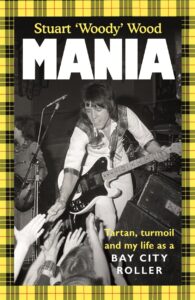 Mania: Tartan, Turmoil and My Life as a Bay City Roller
Mania: Tartan, Turmoil and My Life as a Bay City Roller
By Stuart ‘Woody’ Wood
Autobiography
Between 1971 and 1977, Edinburgh’s Bay City Rollers achieved ten top-ten hit singles, four top-ten albums, two number-one singles and two number-one albums. Yet, despite their success, the boys in the band soon realised that fame was not all it cracked up to be.
Here is the true story of the sensational highs and horrific lows in the life of one band that defined an era.
Continuing with autobiography, it’s time for a much-anticipated look behind-the-scenes of Scottish politics and the highest level.
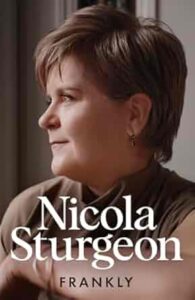 Frankly
Frankly
By Nicola Sturgeon
Autobiography
Whether an independence supporter or not, it cannot be denied that Nicola Sturgeon—the first female and longest-serving First Minister— is one of Scotland’s most influential and successful leaders.
Here she tells her life story with much candour, wit and insight, covering her career’s defining moments including the independence referendum of 2014, Brexit, and the Covid pandemic.
It’s not only those with public personas with important stories to tell . . .
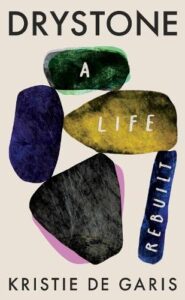 Drystone: A Life Rebuilt
Drystone: A Life Rebuilt
By Kristie De Garis
Memoir
When Kristie De Garis moved to rural Perthshire, she thought she was leaving a life of chaos behind. What she found in the peaceful countryside—and in the craft of drystone walling— was the time and space to confront everything in her past she was trying to escape: racism, trauma, undiagnosed ADHD, addiction, and the realities of motherhood.
Honest, funny, direct and moving, this is a memoir of resilience and finding the life that suits you.
We carry on with a memoir on the wonder and importance of nature . . .
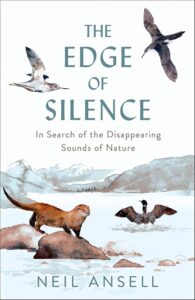 The Edge of Silence: In Search of the Disappearing Sounds of Nature
The Edge of Silence: In Search of the Disappearing Sounds of Nature
By Neil Ansell
Memoir
Acclaimed nature writer Neil Ansell has suffered from progressive hearing loss his whole life. As his world became ever more silent, he encountered an unexpected sound – the call of a great northern diver – and set off on a journey to discover more sounds from creatures he had never heard before. Many of the animals in this moving memoir are close to extinction, and Neil writes brilliantly on a future we must all fight to keep hearing.
Now we turn to the past and a collection of enthralling historical fiction . . .
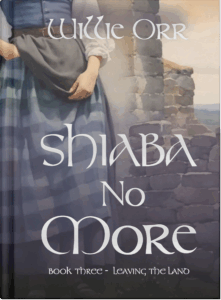 Shiaba No More
Shiaba No More
By Willie Orr
Historical Fiction
Willie Orr continues his masterful exploration of love, resilience, and the fight for justice in the Scottish Highlands through the MacGillvray family. In this novel, we follow Mary MacGillvray as she ventures over the water to Jamaica to work for the wealthy Buchanan family. There she becomes involved in a slave rebellion, and on her return to the Highlands is drawn into the struggles of the crofters against their exploitative landlords.
We stay in the Highlands for our next novel . . .
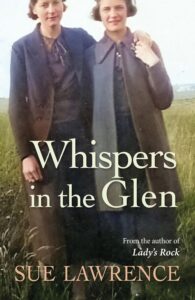 Whispers in the Glen
Whispers in the Glen
By Sue Lawrence
Historical Fiction
In Sue Lawrence’s latest novel, is a tale of sisterhood, heartbreak and resilience of the Scottish women on the home front during World War Two.
Sisters Nell and Effie live together in the North-East of Scotland, and though they love each other, there is a distance between them, and unspoken secrets, and when a soldier knocks on their door with a photo from the past, their secrets just might spill out into the open.
Next, we head to Scotland’s capital city . . .
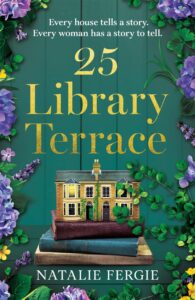 25 Library Terrace
25 Library Terrace
By Natalie Fergie
Historical Fiction
The stories the walls of an old tenement can tell are explored in this intriguing and charming novel that follows generations of women living at one address. We start before World War One with Ursula, a budding Suffragette, and move through the decades until the 2020 pandemic. Each character embodies something of the times they lived in but they also deal with issues – love, loss, family – that are familiar to anyone at any time.
We stay in Edinburgh, but explore it’s darker side with the final instalment of the bestselling Raven & Fisher mysteries . . .
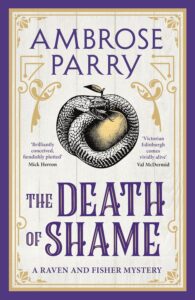 The Death of Shame
The Death of Shame
By Ambrose Parry
Historical Crime Fiction
In 1854, respectable faces hide private sins. When a young lady fails to turn up to her new job at a prestigious household, Sarah Fisher discovers the plight of poor girls ensnared to the city’s brothels. Then a prominent, successful Edinburgh citizen is found dead at the Scott Monument. Are both these occurrences related?
Ambrose Parry finish the adventures of Sarah Fisher and Will Raven in thrilling style, capturing Victorian Edinburgh and its shady corners with wit and and pace.
We head West for another Victorian death by misadventure . . .
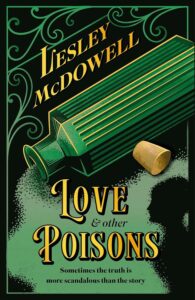 Love and Other Poisons
Love and Other Poisons
By Lesley McDowell
Historical Crime Fiction
Based on a true story of scandalous love, death by poisoning, and an infamous ‘not proven’ verdict, young socialite Madeleine Smith’s life in Glasgow is turned upside down and she must flee the city she grew up in. In the early 20th century, a film scout believes he has found her in America and is desperate for her to tell her tale.
This is seductive, sensational storytelling, full of period detail, twists, turns and thrills.
We stay with crime, we stay in Glasgow, we venture into the here and now. . .
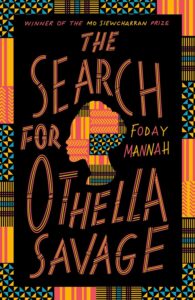 The Search for Othella Savage
The Search for Othella Savage
By Foday Mannah
Crime Fiction
Scotland’s Sierra Leonean community finds itself in a state of shock when a young woman from their church is found in a boot of a car, then another young woman goes missing.
Hawa Barrie is unsatisfied with the police investigation and decides to search for clues herself, worried for her friend’s life.
This is a novel that keeps the suspense high, the pace fast, and explores corruption both political and religious, as well as the power of friendship.
Here’s another crime debut that will keep you on the edge of your seat. . .
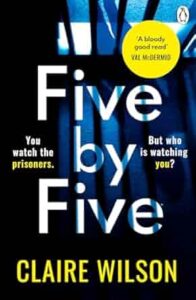 Five by Five
Five by Five
By Claire Wilson
Crime Fiction
Kennedy Allardyce works in one of Scotland’s toughest prisons, monitoring the staff as well as the criminals. She has one guard in her sights, suspected of corruption, but is also distracted by a new, young recruit, the beautiful Molly. But she cannot afford to lose focus on such a dangerous enemy. . .
Taut, tense, brutal, and written by an former prison officer, this is crime fiction that will take your breath away and make your heart beat faster.
We now turn to a more established name, and a master of his craft . . .
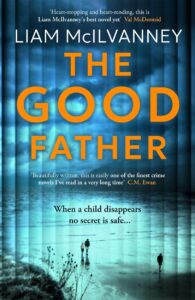 The Good Father
The Good Father
By Liam McIllvanney
Crime Fiction
Gordon and Sarah Rutherford have a good life – good jobs, good friends, good neighbours and a son they love. Then their son goes missing. As the days pass, their hope transforms into suspicion of everyone they know and secrets begin to emerge.
A clever, emotionally-resonant psychological thriller that will stay with you long after the last page has turned, this is crime writing at its very best.
Next, we continue with pacy mysteries, but with a side order of aliens. . .
 The Transcendent Tide
The Transcendent Tide
By Doug Johnstone
Science Fiction
This ambitious novel is the final part of Doug Johnstone’s entertaining Enceladons Trilogy, and Sandy, his peaceful octopus-like alien is behaving strangely while he hides from the US military in Greenland with his human friend, Heather. And there are other strange occurrences when sea creatures start to attack boats in the open seas. A showdown is coming, the future of life on earth is at stake; who will survive?
Staying with the fantastical, here is a fine folklore-inspired slice of gothic . . .
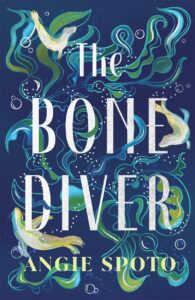 The Bone Diver
The Bone Diver
By Angie Spoto
Historical Gothic Fantasy
The only daughter in a family of Scottish seal-hunters, Kier Sealgair is becoming a burden. She cannot kill, and the family are facing hard times now that her father is ill. Her neighbours, the rich and influential Erskines, give her an offer that seems to good to be true. Should she trust them? Are there secrets to uncover.
The Bone Diver is period gothic tale inspired by the myth of the selkies that is moody, magical and mysterious!
We stay with the Selkie in another gothic roomed romance . . .
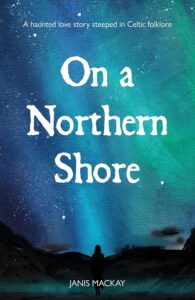 On a Northern Shore
On a Northern Shore
By Janis McKay
Gothic Romance
On Hogmanay, lobster fisherman Rob pours a lonely dram into the North Sea, an old family tradition. Then he meets the mysterious Mairi, sent to his village on a quest for revenge. He is beguiled and confused by this newcomer. Is she a safe bet for his heart?
This is a haunting, haunted love story steeped in Celtic mythology destined to enthrall every reader.
Next, we look to a fantasy superstar at the top of their game . . .
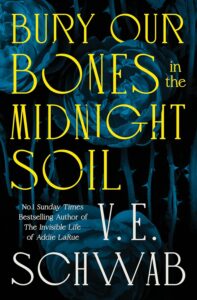 Bury Our Bones in the Midnight Soil
Bury Our Bones in the Midnight Soil
By V. E. Schwab
Horror Fantasy
Three women across three centuries and three countries. Maria, Charlotte, Alice. Medieval Spain, Victorian London and modern-day Boston. Stories of love, hunger and rage; of dreaming, desperation and defiance; of escape, desire and revenge.
In her latest novel, the bestselling V. E Schwab gives us an epic vampiric fantasy that will mesmerise with its lush, poetic language and thrill like all the best pageturners.
We leave fiction now to focus on a collection of smaller delights . . .
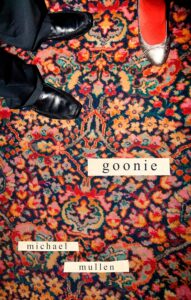 Goonie
Goonie
By Michael Mullen
Poetry
Whether exploring queerness through fierce lyrical poetry or celebrating Mullen’s beloved Scotland through vernacular vignettes, Goonie‘s main preoccupation is with how we form community around us and how community, in turn, forms us.
You’ll be taken round a campfire, a living room ceilidh, a hairdresser’s chair with joy, humour, exuberant language and raw emotion in this brilliant debut collection.
Howzabout some recommendations for our Young Adults?
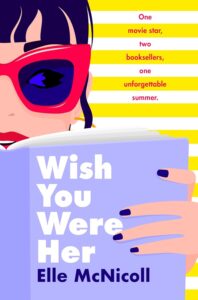 Wish You Were Her
Wish You Were Her
By Elle McNicoll
YA Romance
Enemies-to-lovers? Tick! Small-town romance? Tick! Mistaken identity? Tick! Yes, there may be much-loved tropes here, and shades of classic rom-coms Notting Hill and You’ve Got Mail but when they’re done with the care, warmth and fun —and with a feel-good factor turned up to 11—then you get a novel that is irresistible.
But if your teenager is looking for something a little less cosy . . .
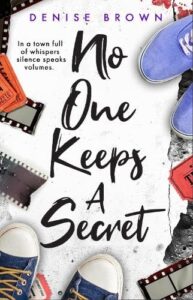 No One Keeps a Secret
No One Keeps a Secret
By Denise Brown
YA Crime
Teenagers Haigh, Cherry and Sunrise track down a missing dog in an abandoned theme park close to their sleepy village, and in finding a chihuahua, discover something else that isn’t quite a cute—a dead body. Now embroiled in a murder case, their town becomes less cosy and full of hidden secrets. . .
And for even younger readers . . .
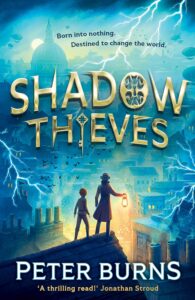 Shadow Thieves
Shadow Thieves
By Peter Burns
Middle Grade Adventure Thriller
In an alternate London, orphan and pick-pocket Tom Morgan escapes a destiny at the brutal workhouse. But his friends aren’t so lucky. Then he is recruited into an international elite boarding school for spy thieves, The Shadow League. He soon finds himself at the centre of a incredible world of danger and intrigue full of thrilling heists, sensational cons and ancient secrets. Can Tom keep up? And can he save his friends?
A proper rip-roaring, edge-of-your-seat adventure story full of fun, action and atmosphere. A new children’s hero is born!
And if your child prefers adventure away from dry land . . .
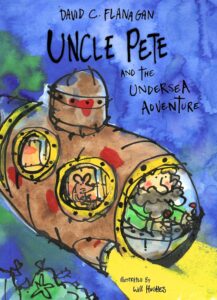 Uncle Pete and the Undersea Adventure
Uncle Pete and the Undersea Adventure
By David C. Flanagan
Middle Grade Adventure
Uncle Pete’s plane has been shot down into the sea and his usual squirrel crew members are on a well-earned holiday. That means he’ll have to adventure into the sea without them, which is trickier than he thinks! And when a curious and clever octopus discovers the plane himself, he might be unwilling to give it back to its original owner!
This is a charming tale of talented animals working together with a big dollop of laughter and silliness.
But we know that not everyone loves the sunshine weather, and many of you are looking forward instead to cosy autumnal evenings. So we’ll leave you with this final recommendation . . .
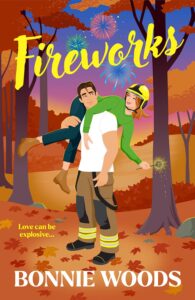 Fireworks
Fireworks
By Bonnie Woods
Romance
Pack up your summer clothes and order that pumpkin-spiced latte for this spicy romance set in the Scottish Highlands as the weather turns. Eiley is a broken-hearted bookseller and Warren is a flirty fireman and newcomer to town. Eiley finds him annoying and self-important, yet so very handsome. And then they have to team up together to save her bookshop. Sparks are going to fly!
Happy Holiday Reading Everyone!
David Robinson thoroughly enjoys Alistair Moffat’s personal history of Scotland after the Second World War, a time of massive social change.
To See Ourselves: A Personal History of Scotland Since 1950
By Alistair Moffat
Published by Birlinn
FOR years now, I have been singing the praises of David Kynaston’s gloriously detailed social histories of post-war Britain. So far there have been five books in his series, though they only go up to 1965. If he is to stick to his original plan of chronicling how Britain changed between 1945 and 1979, he’s got his work cut out. He is 73 now, and I desperately hope he has no thoughts of retiring.
What I love about Kynaston’s books is the way in which they pick up on the minutiae of everyday life – the things which slipped by the consciousness of those of us whose childhood began in the years he covers, making sense of news stories whose headlines we might have heard, uncomprehendingly, on the radio before heading out of doors (of course) to play, reminding us of the tiniest changes on the fringes of our lives: the order of flavours in which crisps appeared on the shelves, when striped toothpaste first went on sale, or why cutting bone meal from pet food meant an end to white dog poo on the pavements. Not perhaps what Proust was banging on about, but a retrospective extension of one’s life all the same.
Alistair Moffat’s latest book, To See Ourselves, doesn’t aim to be a Kynaston clone – even though the latter’s histories dominate his Further Reading list. Indeed, the book’s subheading – ‘A Personal History of Scotland since 1950’ – suggests that that if it owes a debt to any other writer, it is to Fintan O’Toole’s 2022 bestseller We Don’t Know Ourselves; A Personal History of Ireland, which also opens in the 1950s and dances with similar panache on the line between memoir and history all the way up to the present.
If this hybrid form is to be a new trend on bookshop shelves, I’d rather welcome it. For even the biggest Kynaston fan has to admit that his very comprehensiveness comes at the cost of occasional longueurs (unless, for example, you are absolutely fascinated by, say, trends in Welsh nonconformism in the 1950s). The very fact that Moffat’s history of modern Scotland is threaded through with his own experience keeps the reader engaged throughout.
It helps, I think, that he has already written a childhood memoir (Homing, 2003), scratching that primal itch every writer must surely feel about recapturing life’s first surprises and trying to explain what growing up felt like. In To See Ourselves, though, communal history is at least as important as his own recollections – like a photograph album in which the background matters just as much as the faces grinning at the camera.
Take, for example, Moffat’s love of rugby. Growing up in 1950s Kelso, it helped that he was good enough to be a replacement prop for the First XV in 1968 while still a 17-year-old. The glow of nostalgia still lingers, for this was a time when heroes were still local, when ‘one in eight Borderers watched, played or otherwise enabled rugby’ and Borders matches could still attract crowds of 10,000. Moffat tells a lovely story from 1958, when Kelso forward Ian Hastie scored his one and only try for Scotland in a 11-9 victory over France at Murrayfield. The next day, as Hastie made his way past the Moffats’ prefab home on his way to his job at Kelso station, he was berated by Moffat’s beloved grandmother Bina, who had watched the match on TV and criticised him for not running under the posts to make the conversion kick easier. ‘Sorry,’ Moffat heard the big prop forward say. ‘Sorry about that, Mistress Moffat.’
Just look at everything contained within that anecdote. Mistress Moffat, because of respect, manners, and that now horribly overworked word ‘community’. Kelso station, because it still existed, and the report on Hastie’s Murrayfield heroics in that Saturday’s Edinburgh Evening News Pink could presumably make the 45-mile journey to the Kelso newsstands even quicker by rail than road (though, in a triumph of logistics, they were always sale there by 6.30pm). Prefab houses, because in 1944 the government planned on building 300,000 of them for returning servicemen, including apparently one type designed specifically to use up the stockpile of scrap aluminium salvaged from the wrecks of bombers and fighter planes. TV, because before it ‘the only non-Scots, even non-Borderers, I knew anything about were cowboys, Indians and Nazis’, and because it was going to change everything.
As director of programmes at Scottish Television, Moffat would subsequently immerse himself in the world of television and come to see how the professionalism and money it brought into sport would ultimately doom localism, transforming the game in Scotland into one which more people wanted to watch than play. ‘Money produces results,’ he notes glumly, ‘and those results are, therefore, more or less predictable.’
The pithiness of that assessment finds plenty of echoes elsewhere in the book, and Moffat’s analysis of the massive social changes in modern Scotland (decline of religion, depopulation of the countryside, the transformation of shopping and the very slowly swinging Sixties) is always astute. And as countryman, townie, festival director, entrepreneur, historian, TV boss and writer of more than 40 highly regarded books, he has a wider frame of reference than most, as well as a good journalist’s nose for what matters.
Yet there’s no bombast here: Moffat knows exactly how lucky he has been, how much he profited from that great boomer blessing – the Anderson report of 1960, which opened up the possibility of a university education to thousands of working-class Scots by recommending the provision of tuition fees and grants for living expenses while they studied for their first degree. Along with the Robbins report creating more universities, it was implemented in time for Moffat to start his studies at St Andrews in 1968. As he points out, though, the good times didn’t last: ‘It was the beginning of a brief window in history, one that remained open for less than 20 years, a time when there was no bar to educational advancement for young people with ability.’
To See Ourselves taught me much that I didn’t know (for example, that the 1973 Clayson Report transforming Scottish licensing hours originally recommended that children should be allowed in pubs); things I should have known (that before the Thatcher reforms proportionately twice as many Scots than English lived in council housing); things I’d forgotten (that once shops wouldn’t dare sell skimmed milk); and things I just don’t remember at all (how the blue carbon paper in the grocer’s had ‘a strange smell all of its own, like something medical’).
That last snippet of memory is a reminder of just how far removed this book is from any dry anatomising of Scotland. Moffat’s first memory, looking out from his council house at Inchmead Drive, Kelso, underlines the point: ‘In my mind’s bright eye, I see the daily journey of the cows to the dairy as they plod on into the past, their colour fading, their bellows echoing, vanishing like autumn leaves into the darkness and memories of an older Scotland that has all but disappeared.’ Amid all the facts, there’s a poetry in remembrance too.
This confluence of styles – analytical yet elegiac, objective yet personal – makes To See Ourselves a hard book to categorise but an easy book to love. And while I’d like to see more Scottish history-memoir hybrids, I think I’d be hard pushed to find a more engaging one.
To See Ourselves: A Personal History of Scotland Since 1950 by Alistair Moffat is published by Birlinn, priced £18.99
Kevin Guyan’s Rainbow Trap is an enlightening exploration of how social categorisation systems work, particularly within the LGBT community, and how they help and hinder genuine inclusion efforts. This extract shows the author’s own contemplation of societal change as he celebrates his wedding day.
Rainbow Trap: Queer Lives, Classifications and the Dangers of Inclusion
By Kevin Guyan
Published by Bloomsbury
I hadn’t given much thought to the intersection of classifications and LGBTQ lives until my wedding day. In fact, I had never imagined the possibility of getting married. I grew up in the Scottish city of Aberdeen and coming out as gay in the late 2000s felt like putting myself in a box outside the system that sorted everyone else I knew. Gone were the expected milestones of wife, children and house in the suburbs. Nobody knew (myself included) what life-defining moments were now on my horizon. I went to university, my on-ramp for a queer life, and quickly realized that existing outside the main sorting system meant the parties were more fun, the relationships more intense and the outfits far more wild. So it was a peculiar afternoon to find myself in the back seat of a London Black Cab squeezed between my mum, dad and soon-to-be husband just seven months after same-sex marriage was legalized in England and Wales. As we pulled up to the side of the road, I slipped cash under the plastic guard and asked Andrés, ‘Are you ready?’ He focused his dark eyes on me and replied, ‘Let’s go.’ I swung open the door and excitedly stepped out into the leafy square. We felt hopeful that social attitudes towards men marrying men and women marrying women were moving in a more positive direction. Andrés and I were being invited into a system that had, until recently, kept people like us on the outside. On arrival, we were ushered into a wood-panelled back room to meet the Registrar for our ceremony. We could hear the excited chatter of friends and family as they took their seats in the room next door. Younger me had never rehearsed this moment but I felt ready and excited for the future that lay ahead. Yet, looking through the documents in front of us, something seemed wrong. The olive-green form that would become our marriage certificate asked us to write our names, ages and whether we were previously married – questions we had expected to answer. But, at the far edge of the document, were two boxes for the ‘Rank or profession’ of our fathers. Men marrying men writing about the employment history of men. It instantly became clear some archaic requirements of the system remained stubbornly in place.
In sharing vows and exchanging rings, we were about to embark on something that changed who we were as gay men – to ourselves, each other and the wider world. Although our ceremony meant something to us, I was unsure what our actions said about the political and social possibilities of queer lives. In 2012, the cultural historian Lisa Duggan described marriage equality as ‘the singularly representative issue for the mainstream LGBT rights movement, often standing in for all the political aspirations of queer people’. In the late 1990s – when same-sex marriage remained an unlikely possibility among campaign groups in the UK and the United States – gay cultural critic Leo Bersani lambasted the pursuit of marriage and referenced Foucault’s hope that homosexual love could bring about ‘new alliances’ and offer a blueprint for a new ‘way of life’. For Duggan, Bersani and Foucault, rather than expanding our horizons, marriage impoverished our ability to imagine LGBTQ lives that depart too radically from the straight, status quo. With our friends and family waiting patiently for us to take our spots at the top of the aisle, what possibilities (or new ‘way of life’) had Andrés and I abandoned to gain access to a system that, just a few months prior, did not want us?
***
Andrés and I now live in Edinburgh, Scotland and – over the past decade – I have worked as a researcher investigating how UK organizations, businesses and workplaces respond to inequities associated with gender, sex and sexuality. You are likely familiar with DEI interventions such as unconscious bias training, staff networks, pronoun badges, celebration months, allyship schemes and rainbow lanyards. While it felt as if more people than ever were talking about DEI, I grew sceptical as to whether the volume of conversation was having a positive impact on LGBTQ communities suffering the most as a result of badly designed systems. Time and time again I encountered good-intentioned individuals who refused to consider how bigger questions of history, politics and power limited what inclusive interventions could actually achieve. Eyes rolled when I questioned whether ‘debate’ will resolve opposition between trans communities and anti-trans campaign groups or if we really need yet another staff survey to capture more data about the negative experiences of queer employees. My most heated arguments did not involve fascists on the far right or those burning the progress flag at a Pride parade. They were white, middle-class liberals – people like me. Yet, liberal faith in DEI fixes was not matched by evidence of the world around us: the UK has plummeted in international LGBTQ rankings, the number of reported hate crimes against queer communities has rocketed and the Council of Europe singled out the UK (alongside Hungary, Poland, Turkey and Russia) for specific condemnation in its report on attacks to LGBT rights.65 I also sensed an insidious thread running through calls for more of the same, an unsaid discomfort with the direction of change and suggestion that the situation for queer people was ‘good enough’. What I saw among those working in the DEI industry was a dawning realization that access to same-sex marriage, basic legal protections and improved visibility was the start rather than the end for this queer political project. Queer people wanted more. And well-meaning straight people stood in the way.
I had another niggle I could not shake off – an irritation that has niggled a long history of queer thinkers and doers – people’s quickness to celebrate the idea of ‘being included’. While promoting my first book Queer Data I was surprised by the level of enthusiasm among LGBTQ people to share information about their sexual orientation and gender identity with the state even though exercises like the census had run for over 200 years in the UK and, until recently, failed to count people who were not straight and cisgender. Inclusion has become a rallying cry for many LGBTQ equalities organizations, which discounts the risks of being brought into settings that historically ignored or actively excluded us. For example, disability justice writer Mia Mingus has argued that when inclusion exclusively relates to logistics – for example, adding ramps for wheelchair users – then the underpinning ableist culture, which previously did not recognize an inaccessible space as a problem, remains undisrupted. Queer/trans disability studies scholar J. Logan Smilges also calls attention to how a too concerted ‘focus on individuals’ access needs distracts from the messier, meaner, and more systemic ways that ableism operates in our world’ and asks, ‘Does the energy we spend demanding access secure the kind of liberation we want it to?’
The individuals selected for inclusion tend not to deviate from dominant gender, sex and sexuality norms or cause too much trouble – they offer the most tolerable form of diversity. Furthermore, the inclusive interventions that brought them into the system are presented back to minoritized communities as ‘evidence’ that structural or systemic inequities are being addressed. Inclusion invites more people in but rarely considers the negative experiences of those already on the ‘inside’, nor does it acknowledge the box breakers who fail to satisfy the entry requirements or refuse the invitation. When we set our sights on gaining access to long-established systems, slipping standards and a race to the bottom mean we ultimately set a low bar for progress.
Political objectives feel as if they are changing. Increasingly intersectional and inspired by individuals born around the millennium, many queer activists are ambivalent about the objective of ‘being included’ in long-established systems. In this book’s investigation of six systems, I disrupt easy thinking about the ‘promise of inclusion’ and irritate this fissure so that it reveals what ‘being included’ also excludes. This objective goes against the grain, particularly among practitioners working in the DEI industry. Stating that inclusion invites benefits and harms, and these outcomes are not equally distributed across or within minoritized communities does not undo the good deeds of diversity workers and LGBTQ activists. Rather, it sharpens our critical faculties and creates opportunities to expose how some inclusive interventions – and their reliance on classifications – require us to take a medicine that prolongs, rather than shortens, our suffering.
Rainbow Trap: Queer Lives, Classifications and the Dangers of Inclusion by Kevin Guyan is published by Bloomsbury, priced £20
Gillian Sherriffs has written and compiled a unique account of her experience with breast cancer, one that is sure to resonate with many readers. Here, we extract the book’s prologue, which we hope will lead you to seek out this beautifully-produced and honest book.
Elephant
By Gillian Sherriffs
Published by Into Books
Elephant is a book that found me. I’m glad that you have now found it.
It’s a book about connections and I’m grateful to be connected to you.
I have to confess this is not the book I expected you to be reading. Nor is it the book I expected to be writing. Nor, indeed, is it the book my publisher, the brilliant Stephen Cameron of Into Creative, expected to be publishing.
The book I was writing is called The Accidental Immortals. It’s about three women who, in the Scotland of the 1600s, become accidentally immortal.
That was a book about immortality.
The book that found me is about mortality.
My own mortality.
Elephant is the story of a writer diagnosed with breast cancer.
I’ve been writing about illness for the last 18 years. At first, I didn’t have an option. I’d just been diagnosed with multiple sclerosis and was on bedrest, having lost the feeling from my toes to my chest. I was on my own for long periods and I was bored. I was also finding it difficult to sleep due to the nerve pain that accompanied the numbness.
I would wake in the wee small hours with words rattling around my head. During long days of bed rest, I would try to make sense of them. As I did, the words seemed to arrange themselves into long thin poems, which was a surprise, because I’m no poet.
These long thin poems told the story of those initial weeks and all the strangeness that accompanied the sudden onset of serious illness.
After months – and twelve poem-shaped slivers of memory – words stopped waking me up. By this time, though, I was hooked. I’d discovered that when I was fighting with word after word and line after line, I was not aware of the invisible shards of glass sticking into my skin. When I stopped writing, the neuropathic pain would return.
As I ventured back out into the world, the feeling having returned to my body, I made an unwelcome discovery. People were no longer at ease around me.
I seemed to make them uncomfortable.
I didn’t even need to speak to do so. My mere presence was all that was required.
My initial reaction was to feel shame, which I couldn’t understand.
I’d done nothing wrong, so it didn’t make sense to feel this way.
But I did.
My next reaction was to write.
I wrote stories in which I would give a character a neurological illness to see what would happen to them and the people around them; a sort of working out. It was also my way of trying to connect. To normalise illness. To cry out into the void that it can happen to any of us.
At any time.
It’s therefore not surprising that fourteen years later when I found a lump and was told there was ‘something’ in my right breast that shouldn’t be there, my response, once again, was to write.
I wrote my way through diagnosis, treatment and the aftermath of treatment. Sometimes longer pieces trying to make sense of the situation, but most often just short bursts of words. Reaching out to friends, family, clinicians, and to anyone who might notice me waving as I bobbed along on the sea of social media.
If emails, text messages and tweets are the letters of today, then I might be so grand as to call Elephant an epistolary for our times, but that sounds really pretentious.
As I wrote the emails, text messages and tweets that appear in Elephant, I didn’t expect they would one day form the book you now hold in your hands, but no matter how hard I tried to apply my mind to fiction, the story that is Elephant refused to leave me alone. It demanded my attention until I finally succumbed.
It’s the craft of the writer to curate and that is the work I found myself doing. I uncovered over 150, 000 words I’d written from July 2021 until September 2023, and I had to decide where, within them, the story lay.
Then there was the problem of what to call this unusual creation of mine. I struggled with words and phrases. At some point I realised that this book is what I keep doing. It’s an attempt to normalise illness. To make friends with the elephant in the room.
It reminded me of something.
Years ago, I bumped into a friend of a friend in the street.
She smiled and asked, ‘How are you?’
I was struggling with nerve pain and, unusually for me, I deviated from the standard reply.
I didn’t say, ‘Good. How are you?’
Instead, I said something along the lines of, ‘Not brilliant, actually.’
She broke eye contact, muttered about somewhere she needed to be, and was gone.
I went home and, in a matter of minutes, wrote the untitled poem that begins this book.
A book that is not just about illness and my desire to bring the experience of it out into the light but, just as importantly, one that is about friendship and kindness.
On the 24th of May 2022, I wrote the following words:
In the last 250 days I’ve had eight cycles of pre-surgical chemo, two surgeries, fifteen sessions of radiotherapy and am now in cycle three (of fourteen) of TDM1 treatment.
I lost my hair, my eyebrows, my eyelashes, my sense of safety, my sense of dignity (did I mention the campylobacter infection that accompanied the sepsis…?), but not my terrible sense of humour.
I couldn’t have managed it without each and every person who wrote me an email, sent me a text, posted me a letter, hand-drew me a card, knitted me a hat, gave me a scarf, bought me thick woolly socks, sent me flowers, went for a walk with me, made me banana bread, supplied me with Pan Drops, sent pyjamas across the Atlantic, carefully chose a book for me, dropped off a care package at the door, said a prayer for me, or took a moment to wish me well.
Getting to day 250 takes a village.
I’m very grateful for mine.
They say it takes a village to raise a child. I believe it takes a village to get someone through serious illness.
Some members of my village appear in Elephant. Others do not.
This book tells the story of 800 days by carving a path through the more than 150,000 words I wrote during that period. The names that do appear represent all those that don’t.
The people who are mentioned in Elephant are real. They are family members, friends, neighbours, colleagues and clinicians. However, some names have been pseudonymised.
Elephant by Gillian Sherriffs is published by Into Books, priced £30.
Claire Michell and Zoe Venditozzi’s campaign for official recognition of the miscarriage of justice in the country’s historical witch trials has been far-reaching and hugely influential. They have now taken their investigations, knowledge and craft in bringing together their book, How to Kill a Witch, which was released earlier this month. BooksfromScotland caught up with Zoe Venditozzi to discuss the book and campaign.
How to Kill a Witch: A Guide for the Patriarchy
By Claire Mitchell & Zoe Venditozzi
Published by Monoray
Hello Zoe. Congratulations of the publication of How to Kill a Witch – it feels a long time coming! We’ve been aware of your work since you started your podcast, The Witches of Scotland. Did you always want to put your explorations into print?
I’ve got a background as a fiction writer and Claire does a lot of factual legal writing, so it always felt like there would be a written element to what we were doing. However it was only when our now editor approached us and set deadlines that we took it seriously, knuckled down and got writing!
For our readers who don’t know, can you tell us how you started working together?
Claire initially came up with the idea and aims of the Witches of Scotland campaign when she was struck by how lacking in representation Scotland’s women are. This gelled with some research Claire was doing on an aspect of legal history when she read the testimony of a woman accused of being a witch who asked of her jailers if it was ‘possible to be a witch and not know it?’ This was presumably a desperate attempt to clear herself of her charges. When we met some weeks later, we bonded over our love of true crime podcasts and passion for justice and a movement was born.
It’s interesting to read early in your introduction that you were writing your book as a joke guide for the Patriarchy! What made you pivot to the book we have now?
We always planned to write the history of the witch trials with the often arch tone that remains but, as often happens as you write a book, something happens on the page that leads you in a different direction. As I wrote the fiction pieces and pen portraits, Claire ‘translated’ demonology and The Newes From Scotland into more modern language, the book began to take on its real shape. Naturally, we kept the great title!
How to Kill a Witch opens with a poem from Len Pennie, has brilliant fictional vignettes, and cheeky footnotes throughout; it has its historical narrative, portraits, but it also makes serious points about the status of women in society. Why did you approach the book with a patchwork of styles with the content?
One of the campaign and podcast’s compelling aspects, is that we go where the story and our interests take us. The evolution of the book was very similar in that we played to our strengths and fascinations and followed the narrative where it led us.
It blows our mind that the Witchcraft Act of 1735 was only repealed in 1951, and yet the witch trial period seems mainly contained to the 16th to 18th centuries. What do you think were the special circumstances that generated this moment in history?
In Scotland, the act was repealed in 1736 after being signed into law in 1563. Long story short, the five big peaks of accusations in Scotland were down to a horrific combination of great social change; an obsessed traumatised king, the prevailing belief system; ready access to law courts and a zealous, perturbed populace. When things get tough, humans look for scapegoats to make sense of difficulty and to have someone to blame. This didn’t end with the Scottish witch trials.
The story of Helen Duncan, the last woman tried under the Witchcraft Act in the UK is fascinating. What are your thoughts on this last hurrah for these persecutions?
Helen Duncan is a sad case where she was used as an example of how not to behave in times of war. She was thought to be encouraging loose talk and her case was a show trial that made an example of her. Fascinating but very unfortunate.
How to Kill a Witch also outlines where accusations of witchcraft still exist. How do we begin to tackle the superstitious and conspiratorial thinking that perpetuates this oppression?
Critical thinking! It’s key to this issue that we think beyond belief systems and take rational approaches to social issues and human fears.
As well as the book, there have been campaigns for statues, an official government recognition of the injustices of the witch trials, and honorary doctorates. Did you ever envision such results in your campaigning?
Not in a million years would we have imagined the huge, international interest in the campaign. The issue has struck a chord with thousands of people and we’re delighted to have ignited this cultural conversation to recognise not only this historic miscarriage of justice, but also contemporary inequalities for the vulnerable generally, and women in particular.
What next for the campaign? What are your hopes in the reception of the book?
Our aim is to keep educating, keep engaging and to keep being quarrelsome dames intent on smashing the patriarchy.
How to Kill a Witch: A Guide for the Patriarchy by Claire Mitchell & Zoe Venditozzi is published by Monoray, priced £20.
David Robinson finds you don’t need to be a foodie to enjoy Caroline Eden’s books on travelling and eating.
Cold Kitchen
By Caroline Eden
Published by Bloomsbury
It’s probably unfair to judge a book by the number of rabbit-holes it sends its reader down. For one thing, that could be because it is poorly written, or because it doesn’t explain things properly, or just because of downright ignorance on the part of the reader.
In the case of Caroline Eden’s Cold Kitchen, the first two reasons certainly don’t apply. Not only is it a delight to read, but its Edinburgh-based author’s culinary expertise wafts deliciously off the page. She knows her stuff, and has the books to her name that prove it: Green Mountains: Walking the Caucasus with Recipes came out last month, the last in her ‘colours’ trilogy that includes Red Sands: Reportage and Recipes through Central Asia (2020) and Black Sea: Dispatches and Recipes through Darkness and Light (2018).
Cold Kitchen: A Year of Culinary Journeys, which is just out in paperback, is a kind of ‘taster’ for her work – the extra, quintessential ingredient being the care she takes to bring back home, to her New Town basement kitchen, at least some of the flavours of her travels. I say ‘at least some’ because we all know how difficult this can be – how, for example, that bottle of wine that tasted so darkly velvety when the Mediterranean sun was on our shoulders seems such a let-down when drunk in overcast Scotland, or how that accompanying dessert fell so disappointingly short of the golden memory. And yet, even though I am not a foodie, and am such a poor cook that I won’t even attempt any of the book’s recipes, I loved this book. Why?
One of the reasons is Eden’s effectiveness as a scatterer of rabbit holes, and we’ll get to that in a minute, but another is the way each of her chapters is a journey in its own right. It might start off in her kitchen, with her cutting Spanish melons, but before you know it she’s in Samarkand, describing what’s special about the produce sold by the Uzbek roadside melon-sellers, even in night-time, even in November, how they taste ‘like overripe pears with Bourbon vanilla’. And though she might throw in a pinch of esoteric knowledge (qovunxona, n, Uzbek melon shed) or stir in a snippet on the role of melons in Chinese or Mughal history, or Burns’s assassinated first cousin (another melon fan), she brings it back home, like the fine essayist she is, to cubing melon in her basement, with her pet beagle looking up, and enough of her own memories to season the recipe.
In other words, there’s a balance here, as there is in all good writing about food. Between the past (cherished meals in the South Caucasus) and the present (can you really bring it all back home?). Between the most easily romanticised, far-flung places (the remote valleys of Tajikistan, say) and a little electric stove in a cold Edinburgh basement. Between personal anecdotes and memories and the history, nature and culture of the country one is travelling in. Get the balance wrong, and a book can slip away into boorishness on one side and fact-heavy dullness on the other. Eden’s book skilfully skips clear of both.
What makes this even more impressive (to me anyway) is that I am hardly her typical reader. My tastebuds are so insensitive that I have in the past turned down an offer to be a newspaper’s restaurant critic, even though I can easily imagine how much my nearest and dearest would have enjoyed all that free haut cuisine. And although there are plenty of memoirs and travel books on my shelves, I don’t think there’s another one like this with food at its heart.
As a result, I have huge pools of ignorance about food. Take, for example, nigella. No, not Nigella. Nigella I know about, nigella – one of the world’s oldest spices, mentioned in the Old Testament apparently – I didn’t. Burberry I know about – but what’s a barberry? What’s goutweed when it’s at home (and don’t tell me it’s the same as ground elder, because that’s no help either). Sea buckthorn? Never heard of it, yet in Eden’s (brilliant) chapter about taking the trans-Siberian railway to Vladivostok, she casually mentions how partial the Russians are to the stuff and that her Edinburgh neighbour has a business harvesting it – and that it’s a superfood that probably powered the armies (and the horses) of Genghis Khan and Alexander the Great. A superfood that’s changed history and grows in East Lothian? Down the Google rabbit hole I went.
Or take cloudberries. Have you ever seen one? They are rare but they do grow here and in northern England, so there’s a small chance that you might have – small because this single-stemmed berry only seems to grow in high northern places and even then only when there is snow in winter and the right combination of damp, sun, rain and even fog afterwards. Here’s Eden writing about finding and eating one in Glen Affric: ‘I lingered over that single cloudberry, cherishing it, more than caviar, more than whisky or truffles, more than anything else I had eaten, drunk or smoked before.’ I’ll have some of what she’s having, I thought to myself, once more consulting Dr Google.
In fact, if there’s one problem with Eden’s book it’s that she is the kind of guide who opens up a subject so well that you can’t help wanting to find out more. This makes it a slow read: rabbit holes open up in front of you at every chapter. Writing about Baltic cuisine – unfairly neglected, she points out, and a lot more than a pickle paradise – she made Latvia’s capital Riga sound so enticing that I started Googling whether there’s a train linking it with Estonia to the north and Lithuania to the south (as indeed there is: and express trains on it only started running this year). At that great European crossroads city of Lviv, three months before the Russian invasion, she stayed its ultra-grand George Hotel, where Balzac used to stay en-route to seeing his mistress and where the composer/pianist Liszt once waved to his fans from very the balcony of the room she was staying in (£48 a night, says booking.com).
I could carry on in this vein, but you get the picture: Caroline Eden not only writes about places you might never have been to, but from her Edinburgh kitchen writes about food in a way that gets to the heart of what life is like there and makes you want to find out more. In Cold Kitchen, she quotes approvingly from the writer Lesley Branch, whose motto ‘Travelling widely and eating wildly’ could clearly, on this evidence, be her own too.
Cold Kitchen by Caroline Eden is published by Bloomsbury, priced £10.99. Her book Green Mountains: Walking the Caucasus with Recipes is published by Quadrille, priced £28.
In this unique, subversive and intimate hybrid memoir, Katie Goh explores the orange as a means of understanding the world, and herself within it. She covers violence, colonialism, resilience, art and beauty in a book that will make you rethink about the everyday and history’s grand narratives. In this extract, we look at Asia’s influence on art and style in early modern Europe.
Foreign Fruit: A Personal History of the Orange
By Katie Goh
Published by Canongate
Jingdezhen porcelain makers begin catering for the newly wealthy European market. They make shaving mugs and mustard pots and sell them to VOC merchants. But while the Dutch want functional ceramics, they also want their porcelain to look Chinese. One account sent from Batavia, the VOC’s capital in Indonesia, to Taiwan in 1635 lists Europe’s favoured motifs: ‘Chinese persons on foot and on horseback, water, landscapes, pleasure-houses, their boats, birds and animals, all this is well liked in Europe.’ The market for Chinese-looking porcelain is captured in many of Kalf’s paintings, such as his Still Life with a Chinese Bowl, Nautilus Cup and Other Objects (1662), which features a relief of Chinese figures in traditional dress affixed to a blue-and-white sugar bowl beside peeled citrus.
Europe does eventually master its own porcelain. Augustus II the Strong, elector of Saxony and king of Poland, desires porcelain with such a burning greed that by his death in 1733, he owns a thirty-five-thousand-piece collection, the largest in Europe. The ruler is a rampant spender on the luxurious, the exotic, and the desirable, so much so that he diagnoses himself with ‘porcelain sickness’, that is not unlike a hunger for citrus. In a letter, he writes: ‘Are you not aware that the same is true for oranges as for porcelain, that once one has the sickness of one or the other, one can never get enough of the things and wishes to have more and more.’12 In 1701, Augustus imprisons the German alchemist Johann Friedrich Böttger, who boasted that he had discovered how to spin gold. Unable to make good on his lie, Böttger instead works on a recipe for the porcelain-sick ruler with the scientist Ehrenfried Walther von Tschirnhaus. After four years they finally succeed, and in 1710 they establish a porcelain manufactory in Meissen, which continues to produce porcelain today.
Vienna in Austria, Plymouth in England, and Delft in Holland all begin producing their own porcelain. This is not authentic Jingdezhen porcelain but a cheaper, thinner earthenware that resembles the imported items. European ceramists interpret Chinese visual culture for themselves, reproducing popular motifs such as dragons, plants, birds, and people, but severed from their original cultural significance.
In the eighteenth century, reinterpretation of East Asian designs by Europeans becomes its own decorative style, called chinoiserie, which expands to encompass furniture, wallpaper, paintings, and architecture. Like the painted sinaasappels in a still life, silks, lacquered furniture, and porcelain in European households are fashionable for what they signify – the exotic. Chinoiserie is a European interpretation – an appropriation of Chinese aesthetics made palatable for western tastes. It is a hybrid aesthetic, a crude creation of China through a European gaze. This reinterpretation of other cultures is not one-way. In Beijing, the Emperor Qianlong commissions Jesuit artists to design eighteenth-century baroque-style European pavilions in Yuanming Yuan, the city’s Summer Palace.
Authenticity is prized high in culture. We want ‘authentic’ food, ‘authentic’ travel, and ‘authentic’ experiences. ‘Authentic’ may as well be synonymous with ‘real.’ But authenticity is a nebulous quality. As the Silk Roads taught us, societies have been exchanging food, ideas, religions, and genetics for thousands of years. I wonder when an inauthentic creation becomes a style in its own right. When does Dutch porcelain with its Chinese motifs assimilate into the history of art, not as a cheap version of East Asian ceramics but as its own hybrid visual identity?
Immigration is the hybridising of multiple cultures, as is the mixing of families of different races, nations, and religions. My father using the leftover trimmings of a roast dinner in his Malaysian curries is perfectly inauthentic and perfectly delicious. Immigrants who open restaurants of their national cuisines often transform their cooking to cater to western palates. Chinese, Indian, and Thai takeout restaurants may not be authentic, but in their inauthenticity, something new and hybrid and delightful is created.
Being mixed race is, of course, being a hybrid of two cultures. The language of mixed identity, from the more innocuous – half of this and half of that – to the more insidious – the one-drop rule – is loaded with accusations of inauthenticity. I could fill the rest of this book with the offhand comments that have been levelled at my racial identity, but all of them had the same effect: of segmenting me into halves and quarters until my sense of self was almost entirely cut away. During the pandemic’s surge of anti-Asian violence, these voices from the past returned as a whisper in my mind that questioned if I was even Asian enough to have the right to feel this much sorrow.
Looking back now, I see that my childhood obsession with authenticity – and my frustration when I failed to capture what I thought was authenticity in art – was about trying to feel real. Growing up, I felt out of step in a world that was rigidly organised into categories of difference. I was not Asian or White but Other; not Straight or Gay but Other; not British or Irish but Other; not Protestant or Catholic but Other. This third, hybrid identity had no borders and no models to guide me. Now I know and love so many people who live along the spectrum of Other, between what our society considers fixed identities. But I felt alone as a child, and I thought that if I couldn’t pin myself to one identity, then I did not exist. I felt half finished, half authentic, and half of something else – which really meant that I totalled nothing.
But the world is made of hybrids. Purity is an illusion. We are born of two parents. Even the orange is the offspring of different parents: the mandarin and the pomelo. Art has always taken its inspiration from numerous wells of ideas. A still life is a construction half of imagination, half of reality. A contemporary ceramist shapes their porcelain after both Chinese and Dutch models. History is too various to offer a single narrative. Life is composed of shards of glass, all slotted together to make a mosaic. No one is born complete.
Foreign Fruit: A Personal History of the Orange by Katie Goh is published by Canongate, priced £16.99.
Emma Cowing’s debut novel The Show Woman is an beautifully-told, action-packed tale of the first all-female circus in Edwardian Britain. BooksfromScotland chatted to her about how the hidden stories from history should be brought out into the open.
The Show Woman
By Emma Cowing
Published by Hodder & Stoughton
Well done on publishing your debut novel, The Show Woman! How have you enjoyed your journey into publication so far?
Thank you so much! It has been a rollercoaster so far, but very much of the fun kind. I think what has surprised me most is how much of a team effort it is to publish a book. From cover designs to marketing plans, working with my brilliant editor Jo Dickinson at Hodder and the creative input that stretches across the publishing house, there’s so much that goes on behind the scenes to get every book you see in a bookshop on to the shelf. It’s been exciting, and very humbling!
What can readers expect from your novel?
Thrills, spills and all the fun of the fair as four young women come together in Edwardian Scotland to create the first all-female circus act. You’ll meet strong female characters striving to make their way in a man’s world, lions, elephants, and an adorable horse named Tommy Pony. At the heart of the story is a long-buried family secret that threatens to tear apart the Ladies Circus for good. You’ll also see quite a bit of Scotland along the way, as the circus travels from Glasgow’s Vinegarhill showground up to Aberdeen during the 1910 summer fair season.
The inspiration for The Show Woman came from a family member. Can you tell us more about that?
My great aunt Violet was a trapeze artist and bareback horse rider, and her parents were showpeople who traversed the fairgrounds of Scotland between the 1880s and the 1910s with their travelling theatre. Learning about their lives, partly through official documents (under profession, many of my female family members were described as ‘showwomen’) and partly from the family stories my Mum remembered from her childhood, was hugely inspiring. I knew I had to write about it.
Have you inherited any unexpected skill you can share with us?
I am the world’s least flexible person so definitely not the trapeze! However I am musical, as some of my great aunts and uncles were, and as a child played a tiny quarter size violin which was passed down to me from Violet’s brother. My family would also say I quite like telling people what to do, so perhaps, like the character of Lena in The Show Woman, I might be a good ringmistress…
Have you always been interested in women’s lives and status in history?
Absolutely. Women are so often relegated to the sidelines of history, and yet when you really delve into it they were front and centre, but their stories remained untold. Part of what drew me to writing about the world of Scottish showpeople is that it is hidden history, and as we know, women’s history itself is often hidden history. Combining those two factors was really interesting to me, and a tale I thought deserved to be told.
Other than the women in your family, do you have any other rebellious ladies you take inspiration from?
From Mary Queen of Scots to Agnes Randolph, Scotland has always had its fair share of rebellious women (I absolutely loved Mairi Kidd’s Warriors and Witches and Damn Rebel Bitches which covers this topic beautifully), and I’m always on the lookout for stories of women who dared to challenge the conventions of the day.
For my next novel, which is out in Spring 2026, I’m staying in the Edwardian period but delving into my husband’s family of Italian immigrants as well as the world of London’s Gaiety Theatre, where women took to the stage and became pinups at a time when the notion of celebrity was in its infancy. Most of the action takes place at a country house party on a Scottish island and I’ve had a lot of fun playing with societal structures and stereotypes, and what it meant to lead a fulfilling life as a woman at a time when we still didn’t have the vote. I think I’ll always be drawn to women who are outsiders.
Your day job is in journalism, so you’re used to writing to deadline. How was the switch to novel writing where you have more space, but you still have to balance this with structure and momentum?
It was definitely a shift. For a long time I was writing chapters the exact word length of the features I wrote in the day job. It was a bit of a process to understand that I had more freedom in novel writing, that a chapter could be as long or as short as I liked. It was a similar thing with structure and momentum. Once I realised I was in control, that it was my story and I could tell it exactly the way I wanted to, I absolutely revelled in the freedom.
What kind of novels do you enjoy reading?
I adore historical fiction, as you might imagine, and recent favourite reads include Kate Foster’s The King’s Witches, Stacey Halls’ The Household, Joanna Miller’s The Eights and Fiza Saeed McLynn’s The Midnight Carousel. All time favourites include The Cazalet Chronicles by Elizabeth Jane Howard and everything ever written by the peerless Sarah Waters.
What has been your favourite read so far this year?
There have been so many (2025 is shaping up to be such a great year for books), but my absolute stand out is Clare Leslie Hall’s Broken Country. A magnificent novel about first loves and heartbreaking loss with the pulse of a thriller. I couldn’t put it down.
The Show Woman by Emma Cowing is published by Hodder & Stoughton, priced £16.99.
Inspired by a true story of one Scot’s rise to prominence, Murray Hall is a historical fiction novel that takes the reader to a dazzling turn-of-the-century New York, where the eponymous Hall has a secret that is only revealed after death. In this extract, a journalist determined to discover the truth speaks to one of Murray’s gambling buddies.
Murray Hall
By Milo Allan
Published by Black and White
Joe Young’s eyes gleamed green in the electric light of the card room. I had remembered them grey, like Hall’s, from our first meeting, but I now saw the depths of them like a briny sea.
‘Ah take it you know how to play the Widow. Thirty-one? It’s a simple game but it was one of Murray’s favourites. Better to play with three or four, but we can play it fine enough with two.’
A pack of cards danced between his hands, fluttering like sparrows taking to the air, then caught between his deft fingers.
‘I’ve played it a number of times,’ I replied.
My father’s voice murmured through the back of my mind as the cards spread like a lady’s fan at the opera, then closed again. We must, as we battle for reform, not allow ourselves to be deformed . . . Gambling, cards, disorderly houses, the pool room, all these can divert us from holiness.
‘The aim being to be the player who has collected cards closest to a total of thirty-one,’ he said as if he sensed my uncertainty. ‘A dollar note on the table, and each life you lose, you fold the corner. No more than a dollar lost in the whole game.’ He chuckled. ‘Ah sense you’re not a gambler, Mr Clellan. Ah know, of course, your aversion to such base pleasures. But if you’ll permit me a game, ah’ll tell you about my friend Murray Hall.’
The two candles of the bouillotte lamp bathed the mahogany surface in light, sharpening Joe’s features as he leaned inwards to offer the deck towards me. ‘Cut,’ he instructed, and I did as he said.
‘The Widow,’ he repeated as his muscular, nimble hands dealt three cards to each of us, then slid a further three down onto the centre of the table. ‘Strange how many card games are named after the female cards, don’t you think, Mr Clellan?’
The man leaned back into his chair and inhaled deeply. He appeared to be studying me, just as he had those few years ago in Fatone’s. He hadn’t changed much, save the hint of grey in his moustache. I wondered for a brief moment if I had. He drew a box of cigars from his pocket and offered me one. I raised a hand and shook my head, then watched as, with a smirk, he lit his own.
‘They say Murray Hall fooled many shrewd men. Well, you can count me as one,’ he said, taking a long draw. ‘Your start.’
I turned my cards towards me. On the table, flipped upwards, the flop contained a further three: a five of diamonds, a seven of clubs and six of spades.
‘Murray loved this game,’ he went on. ‘First time ah ever saw him was in the back room of the saloon on the corner of fourteenth and sixth in the run-up to the 1883 senatorial election. Ah hadn’t gone in there looking for a poker game, just a drink and to eavesdrop on the gossip of the County Democracy crowd. Ah drifted into that room because the whisper in the bar was that they were back there, playing, and there was a big pot already building. This, ah figured, might be a game of some interest. Quite how much, I could not have imagined. Needless to say, ah played him at cards that night and lost.
‘Always remember the first glimpse ah had of the little fellow with the hat, silhouetted at first by the lamp behind him. Watchin’ him play, ah soon realised that this was the fella people had been talking about. Murray Hall. Ah remember how he played, cigar between his teeth – though I don’t believe he lit it. At one point he held out a trey, a three, for a “kicker”, and, blame me, if he didn’t pull another three and a nine spot.’
‘I heard the woman was a remarkable shark – a killer instinct,’ I said, fighting to resist a smile as I stared at my cards. There, already, was an ace of spades and a Jack of spades, an early score of twenty-one. On the table, a further six. I waited for a moment, as if assessing my hand with uncertainty. If I could have knocked right then in the first round, I would have.
‘That night he beat out three aces and swept up over a hundred dollars,’ said Joe, cigar smoke obscuring his face for a moment. ‘And this was a woman, a fella who stood two raises, on only two nines? Ah don’t believe it . . .’
I reached forward and pulled the six of spades towards me, replacing it with my nine of hearts. The man opposite smiled and plucked his hand off the table. He glanced at the cards for barely a second before he took my nine of hearts.
‘It seems, over time, you got to know her better than most,’ I tried as I rearranged my hand. His manner was so casual that I wondered if he could possibly have forgotten our first meeting, if the incident was so frequent, or myself so unmemorable.
‘Did ah know him well?’ he said, resisting the feminine pronoun. ‘You reporters and your questions! What does that mean? Ah knew his style as a poker player, what cigars he smoked, who he would lay a bet on in a fight, and what he was like to come up against in an election match, but if you’re asking me for details about where he came from and how he ended up in the city, you need to look elsewhere. Ah reckon most of us Tammany boys would say the same.’
I studied the face, the scar like a pencil line leading down to those jade-coloured eyes. Could he truly have forgotten me? No, I thought, it was more likely the man was playing me, waiting to see who would cave first. But I was far from caving.
I knocked gently on the table. My heart pounded and I spread the three, the ace, the jack, the six. ‘Twenty-seven,’ I said, now allowing myself a flicker of a smile.
‘Nice,’ he said, as he laid out his own spread of nine and ten of hearts. ‘A lucky first hand.’ Joe’s fingers reached forwards to pick up his dollar bill, flattening it on the table before turning one corner inwards. ‘One life gone,’ he said as he creased it with all the precision of Japanese folded paper.
‘Ah’d say Murray was one who lost a few lives along the way. So be it. Lives are made to be lost.’ Those eyes held my gaze for a moment and he pushed the deck of cards towards me, his hands hovering a moment longer than I expected before he pulled away. ‘Your shuffle, sir,’ he said. The eye contact did not waver.
Murray Hall by Milo Allan is published by Black and White, priced by £16.99.
Muckle Flugga is the debut novel by Edinburgh Makar, Michael Pedersen. We chatted to him about his writing life so far.
Muckle Flugga
By Michael Pedersen
Published by Faber
Hello Michael, it’s lovely to have you back here on BfS. So, you’ve given us poetry, you’ve tackled non-fiction, and now you’re releasing your first novel, Muckle Flugga; it’s all very exciting! When you started out writing, did you see yourself adventuring across genres?
Oh I’ve long worshipped at every literary altar I’ve come across. A cherisher of all genres, and a traitor to each. But, hey, I also love the stuff that dwells in-between these categories and realms – prose poetry melding into poetic prose; autofiction burling with biographical fiction; the literary misfits and pariahs that blur expected boundaries.
Poetry has been my staple, it oozes everywhere, all my prose is caked in the stuff.
In truth, I started writing non-fiction by accident because the words wouldn’t settle as poems. But suffice to say, the whole time, I’ve been building up to this first novel.
What can you tell our readers about Muckle Flugga?
Muckle Flugga is a book wrought with landscape and lore, bumps-in-the-night and celestial secrets; part friendship love story, part character drama, part starry-eyed waltz with the world.
It starts on a remote and rugged island, with a lighthouse standing sentry, its beam charged by starlight.
I knew it had to be a small cast: a lighthouse keeper and his dreamy son at the centre of it all – their world thrown off axis by a stranger’s arrival. It’s an old bonds up against new scenario with a deep historical resonance.
We love the thought here of literary Guardian Angels, so were tickled to read of Ouse’s friendship with Robert Louis Stevenson. We absolutely love his advice in the book! What does he mean to you as a writer?
I adore RLS, he’s a dreamer, not a lighthouse engineer like the rest of family, but an imagineer that enlivens minds and doles out courage via his adventurous tales. My mum used to read me the poems from A Child’s Garden of Verses when I was a kid – she even put some to music for the bairns she taught at nursery (being a creatively driven nursery nurse in the Leith area of Edinburgh for most of her working life).
Also, I won the Robert Louis Stevenson Fellowship a while back and got to travel to the verdant Grez-sur-Loing in France and stay at the infamous Hotel Chevillon (for a long November). So I stalked RLS to where he conjured a lot of literary lustre, and also met and fell for his wife-to-be Fanny Osborn. As I strutted around that village the air was lust-laden with inspiration and had me pondering with renewed purpose. If Muckle Flugga gets made into a blockbuster movie I’ll bring back that Fellowship – it changed me as both a writer and a person. I am indebted to RLS for its existence.
And did you have fun writing his character?
It was a total ball, but also terrifying. I’m a fervent RLS fan but by no means an academic source on his writing, my erudition is juvenile. And, well, there’s RLS aficionados the world overflowing with astounding knowledge on the great man.
I will say I got unique access to the RLS archive held by National Library of Scotland, via the curator Colin McIlroy, which bequeathed upon me some special insights. And also I drew a lot of sapience from a few key texts, namely: A Friendship in Letters: Robert Louis Stevenson & JM Barrie edited together by Dr Michael Shaw. That plus Bella Bathurst’s extraordinary book: The Lighthouse Stevensons. Oh, and the former President of the Robert Louis Stevenson Club, the good Dr Mitchell Manson, was kind enough to lend me a chunk of his collection, and helped unriddle a few riddles I was roosting on.
Have you ever been to Muckle Flugga? And the lighthouse? Or did you want to keep the place entirely imaginary in your head while you were writing?
I quested to the nearby island of Unst with Bill Drummond as part of a Neu! Reekie! adventure back in 2019 – together we gazed upon Muckle Flugga across the ocean. We also got invited into Muckle Flugga Shore Station (situated on north Unst) for Bill Drummond’s unofficial birthday party, which he ambushed upon an unsuspecting fan who’d invited us there for brunch post a couple of shandies at the previous night’s event.
I’ve a novel launch event with Shetland Arts at Mareel in July, me and Hollie McNish are going to try and journey there then. Hopefully with a bit of help from the fab Shetland poet Roseanne Watt, who’s also doing the show.
I will caveat the above by saying, my Muckle Flugga, though based on the real life Muckle Flugga we swooned over, has perhaps grown to ten times its size. And beyond that my island is known to shape shift, never fully settling. It carries something occult in its soil.
An absolutely fantabulous book map has been inked up by book map supremo Neil Gower to offer visual aid, should you need it. Book maps being very much in the RLS tradition.
Right away, we are drawn in to a world that is both recognisable yet dreamlike or reminiscent of fairytale. What are your thoughts on style and tone in writing?
Tones are less definable to me than notions of tenderness and tension and the rumination that orbits around them. That’s the type of mix I love, and that’s the ilk of storytelling that enthrals me.
I’ve been described as relentlessly optimistic, often flamboyant in my language, and I’m sensational in my soppiness, it’s all true / guilty as charged. But I love human complexities too, the grit and the struggle – we are all vulnerable beings wrangling with the massiveness of the mind and our place in this universe. I took all this to oath, and kept it close as I wrote and edited this book.
I also wanted to sculpt a character drama that felt it was deeply entrenched in the type of friendship love stories I lionise – the ones I seek out when lost and fragile and hungry for hope. Issues of class and identity had to rear their heads, alongside natural world wonderment, with modest flashes of magical realism.
In our wider quotes for the novel people reference JRR Tolkien, George Orwell, Margaret Atwood and Alan Garner, and naturally I was elated by all those literary tones, whilst paying tribute to the magnificence of each of their opuses. That’s to say, I wouldn’t be so brazen as to summon any of these giants in comparison, but I do adore all their multi-tonal writings and hopefully some of that seeps in – be it by tealight or tincture.
There is darkness behind the flights of fancy, on grief, loneliness, fear and regret, yet it’s done with depth and a lightness of touch or economy, that we’re wondering if you think your poetry background helped you with your novel writing?
Poetry helps me investigate and understand the world; it helps me project my life into other people’s lives and invite them into mine. It’s never been about forensically pinning down the right answer for me, but learning to ask empowering questions that light the way forward. Even a glisk of light can be enough to rope the way home to a poor soul lost at sea.
That’s to say, yes – the poetic engine, the emotional compass within it, is revving in every sentence of this book, it helped steer me to shore.
As someone with a background in events organisation (long live Neu Reekie!) do you enjoy the promotional side of the writing life?
Unwaveringly, yes, I do. I love learning how to best represent the book in a live manifestation, injecting it with performative exuberance or unfurling from within it deep discussions. I love conjuring the launches and inviting kindred spirits to talk to me about the work and engage with the themes. I love talking to readers who the book has thrummed for, or who might have niggling questions, or impasses, they need answers to – quirks that exist in the novel’s hinterland, for better or worse.
On this gigantic novel launch tour, I’m in-conversation with / or performing alongside the likes of: Stephen Fry (Hay-on-Wye); Jackie Kay (Edinburgh); Val McDermid (Edinburgh); Denise Mina (Dollar); Fern Brady (London); Nicola Sturgeon (Glasgow); Hollie McNish (multiple locations); and more. What a carousel of joyous humans to be able to soar with – exquisite creatures each and all. My gratitude is gargantuan and growing, I’ll not mince my words here.
You were also named Edinburgh Makar last year. How have you found the role so far?
Och, yes, I’ve love this role too. What an honour. To celebrate Edinburgh and poetry, preferably in unison, is how I go through life anyhoo, that revered banner naturally adds some additional bravura.
I look at the Makarship more as what I deliver than anything else. My first project was to launch the Edinburgh Makar’s Poetry Prize and get more young people writing poetry. Alongside the ace Janette Ayachi and Super Power Agency, we parachuted into three state schools to run workshops, give talks and launch a writing competition – aye, on the theme of friendship. And what a wealth of luminous entries we got. I’ll be growing that competition year on year.
There’s a couple of salient pieces I’ve conjured in the role. The first was being enlisted to write a poem to front a Samaritans campaign, helping launching their new SamariTartan range (yes, they had me at the name). The second was being tasked with sculpting a poem to celebrate Edinburgh turning 20 as the world’s first UNESCO City of Literature with nods to the city itself turning 900 years old – my ‘great Edinburgh poem’, so to speak. I tussled with this, the bifurcated soul of this city is rich with both marvels and mischief, but in the end it all came back to its people. I’m chuffed with how each project came to fruition.
There’s more interesting work to follow with the likes of Dynamic Earth and Edinburgh University Medical School (who’re turning 300 years old – imagine, aw them doctors and nurses and the lives they’ve saved), but I’ll keep schtum on that for noo.
My mettle is mottling as we speak.
Muckle Flugga by Michael Pedersen is published by Faber, priced £16.99.
Nina Allan has written a fantastic new novel, A Granite Silence, that explores a murder of a child in Aberdeen in 1934. It’s a hugely inventive novel that also explores how stories are made and how creativity happens. We spoke to Nina about her favourite books.
A Granite Silence
By Nina Allan
Published by riverrun
The book as . . . memory. What is your first memory of books and reading?
I can barely remember a time when I wasn’t reading. Very early memories include the Ladybird Books version of The Little Red Hen, which I actually found quite frightening but could not keep away from. Another early favourite was John Burningham’s Borka: The Adventures of a Goose with No Feathers, which I still find absolutely magical. I soon moved on to the Enid Blyton ‘Adventure’ series, and from there to everywhere else. By the time I was seven, I could not imagine being on a long car journey or anywhere, really, without a book to keep me company.
The book as . . . your work. Tell us about your latest novel A Granite Silence. What did you want to explore in writing it?
A Granite Silence tells the story of a real crime that took place in Aberdeen in 1934. The case attracted an enormous amount of press attention at the time, but has fallen out of the conversation since, at least partly because of the massive social and societal changes brought about by World War Two. The coverage of the trial in the newspapers brought to light some of the ways in which women were set at a disadvantage in the all-male world of the justice system, and I wanted to shed some light on that. The case was also one of the very first to have hinged on the scientific analysis of forensic evidence. Scotland was in the forefront of the development of forensic science, a fact I thought it was both interesting and important to draw attention to. More than anything though, I wanted to foreground the lives of ordinary working people in what could be a harsh urban environment. Families living in Aberdeen tenements were crammed close together with minimal facilities – tensions could run high, even between those who were normally on friendly terms. I would like to think that readers of A Granite Silence will come to know the people involved in this case as if they were their own neighbours.
The book as . . . inspiration. What is your favourite book that has informed how you see yourself?
Reading Sylvia Plath’s landmark poetry collection Ariel for the first time at the age of sixteen taught me everything I needed to know – both then and for the future – about the realisation of a personal vision through the medium of the written word. Plath’s immaculate synthesis of feeling, form and image can never be bettered in my eyes. My response to Plath’s work now remains as passionate as it was forty years ago, and reading her always leaves me both inspired and fortified. I would also add that anyone wanting to discover more about Plath’s life and work should seek out Heather Clark’s 2022 biography Red Comet. It is better than any of the others by some distance, centring Plath’s achievement as a poet and dialling down some of the rhetoric around her relationship with Ted Hughes.
The book as . . . an object. What is your favourite beautiful book?
This would have to be my Folio edition of Truman Capote’s In Cold Blood. As well as being one of the finest examples of true crime literature ever written, this particular edition contains some of the original photographic reportage of the crime at the centre of the story at the time it took place, images that formed part of Capote’s extensive files of research materials and that would have been there on his desk as he was writing. They are, still, immensely atmospheric. I like always to have this book in mind as an example of what can be accomplished in the field of the ‘factual novel’, as Capote himself referred to it, and this Folio edition is just such a joy to handle and read.
The book as . . . a relationship. What is your favourite book that bonded you to someone else?
My late husband and I talked about books non-stop, every day of our life together, but one particularly precious memory concerns the time soon after we met, when we were constantly comparing notes on the books that meant the most to us. I remember describing to him a novel I’d read when I was in my teens, a work of speculative fiction that imagined a world in which Queen Elizabeth 1 had been assassinated and Britain became a strictly Catholic country, with all development of the sciences firmly repressed. The book had made such a deep impression on me I could remember entire chapters virtually by heart – but I had no memory of the title or the name of the author. My husband was able to tell me even before I’d finished describing it that the novel in question was Pavane, by Keith Roberts, now seen as a classic of British speculative fiction. It turned out that he had read it on first publication in 1968 and it had always remained one of his favourite books!
The book as . . . rebellion. What is your favourite book that felt like it revealed a secret truth to you?
I first read Arthur Koestler’s 1940 novel Darkness at Noon in my late teens, and reread it several times over the following decade. The novel’s protagonist is Nikolai Rubashov, a committed communist in Stalin’s Russia who inevitably ends up falling foul of the secret police. The arguments rehearsed in the book – about art, about freedom, about whether the ends can ever justify the means – parallel Koestler’s own philosophical struggles and loss of faith in political ideology and had a profound and lasting effect on my own thinking.
The book as . . . a destination. What is your favourite book set in a place unknown to you?
This might well be Michel Faber’s The Book of Strange New Things, which takes place on another planet! The main character, Peter, is being sent as a Christian missionary to the planet of Oasis, while his wife Bea is left behind to cope with life on Earth amidst the accelerating problems of climate change and deepening social inequality. At the time Faber was writing this novel, his wife Eva, an artist and photographer, was dying of cancer, and Peter’s experience of estrangement and grief strongly reflects Faber’s own, albeit within an entirely different context. In Peter’s interactions with Oasis and its people, Faber has succeeded in creating a genuine sense of alien-ness as well as a strange kind of beauty. This is a novel that repays multiple readings and that has a truly timeless feel.
The book as . . . the future. What are you looking forward to reading next?
I am about to start reading Daniel Kehlmann’s brand new novel The Director, which tells the story of Georg Wilhelm Pabst, the great Austrian film director who flourished under the Weimar Republic but who was later forced into a deeply uncomfortable relationship with the Nazi Minister for Propaganda, Josef Goebbels. Kehlmann has often based his novels around historical events involving real characters, but he always approaches his material from an unexpected angle and produces work that hovers mysteriously between the real and the imagined. I’ll read anything he writes!
A Granite Silence by Nina Allan is published by riverrun, priced £20.
Thirteen-year-old Samim is a loyal friend, a gifted chess player — and a refugee. After his family is killed in a bombing, Samim makes a long, dangerous journey from Afghanistan to the UK. But even then his safety isn’t guaranteed: Samim must tell his story to convince the authorities to let him stay for good. Here is an extract describing a moment in his escape.
My Name is Samim
By Fidan Meikle
Published by Floris Books
Istanbul, Turkey, spring 2021
At Uncle Amir’s house, every morning at nine his sons brought tea and bread to our room. It was the routine everyone got used to, so we were all dressed and ready by then.
But one morning, we awoke to a knock at around six, and everyone knew it was time.
‘You have ten minutes to get ready,’ Uncle Amir said, peeking into our room.
We gathered at the front door, and he handed us small food packets for the road. The handler with yellow teeth stood at the doorstep, leaning on the wall, smoking. He had a list in his hands.
‘Samim, Zayn, Adel.’ He muttered the names with the cigarette between his teeth, clouds of smoke blowing out of his mouth.
Uncle Amir motioned to us with his head to follow the handler.
Darya, Zayn and I shared excited looks. We were so happy to leave together!
We piled into the taxi, our chests throbbing with both joy and dread.
‘Save your snacks,’ Darya warned us.
Three hours later, we swapped the taxi for another car driven by an old handler who never spoke a word to us. The Turkish sky outside the windows was blue, the sun was warm, and as I sat next to my two best friends, flutters of hope warmed my chest.
We talked, laughed, argued, interrupted each other and dreamt aloud. We wondered what our future homes would look like and what our friends would be called. We talked until we were breathless, and then we sat quietly for a while. In silence, drops of fear seeped into our chests, and we thought of our lost families.
At midnight, we arrived at the seaport called Çanakkale. As soon as we got out, we felt the salty breeze on our tired faces and heard the wails of seagulls. We couldn’t see it in the dark, but we knew the sea was close.
The driver led us to where a group of around thirty people stood in silence, surrounding a tall, bearded man who shone a torch on a piece of paper. The air smelled of fish and fear.
The sea was calm, its waters motionless, like black glass. The pale moon hung over us, unfolding a thin golden path like a carpet towards the horizon.
The moon is showing us the way, I thought.
Our handler exchanged a few words with the man, among which we heard our names and the name of our smuggler, Mustafa. Then, the handler gave us a plastic bag with water and biscuits.
‘Go with God,’ were his only words, but his gaze was full of pity.
Zayn, Darya and I looked at each other as the trickles of fear in our chests turned into streams.
The handler walked away, and the bearded man tossed us three red life jackets. We wrestled them on, then clambered, one by one, into a dinghy bobbing beside us. The bearded man was the last to board. He started the engine and passed the torch to the man sitting by the tiller, gesturing forward with his arm. The man at the tiller gave him a timid nod, and the bearded man leapt from the dinghy, untied the rope from the post and walked away without looking back.
People shouted after him in panic. ‘What are you doing? Come back! Where are we meant to go?’
But the man dissolved into the night as we drifted further and further away from the shore.
My chest tightened with panic. Why hadn’t he got in the boat? How were we meant to navigate it ourselves?
The man with a torch wiped the sweat off his stubbly face, kissed the wedding ring on his finger and gripped the tiller tightly. He stared into the murky void ahead, his wild eyes flashing white in the dark. I don’t think he had ever steered a boat before. He had probably never seen the sea before. But people do whatever it takes to survive, and that night, the man who had never seen the sea became our captain.
There were twenty-eight of us, packed in like dates in a crate, rubbing shoulders with one another, feeling each other’s breath on our necks. But although there were so many of us – men, women and children – no one spoke, which meant there was no distraction from the fear squeezing our chests.
Drops of cold sweat covered my face as the town lights behind us grew smaller and paler.
Soon, it was just us: a bunch of castaways jammed on a tiny dinghy, with blackness above, beneath, around and inside us.
3.14159265358…
‘We’re going home,’ Darya said, sitting between Zayn and me, her eyes smiling.
‘We’re going home,’ I muttered under my breath. This must be the best sentence in the world. A spark of hope flared in my chest.
But a few hours later, our engine started shaking with thunderous coughs. The dinghy slowed down and then stopped altogether. The sharp smell of gasoline filled the air.
‘It’s leaking! The fuel tank is leaking! I think we’ve lost all our petrol!’ our captain hollered, his eyes wild.
And with his voice, the black silence around us shattered like glass. People screamed and gasped, men tried to stand up to look at the engine, and the dinghy swayed from side to side.
‘Stop! Stop moving so much, or we’ll all end up in the water!’ our captain yelled, and everyone went quiet.
‘What do we do?’ a voice in the dark asked.
But no one had an answer.
Men tried to use their arms to row, sweat dribbling off their breathless faces, but hours later, we had hardly moved.
The silver moon glowed as our sorry little dinghy bobbed on the never-ending inky waves.
We spent the night praying.
‘We’ll be alright, don’t worry,’ Darya said to two sobbing kids across from us.
Their snotty faces were warped with fear as they clutched their mum, a thin woman with a gaunt face who swayed from side to side, eyes shut, lost in prayer. She was rubbing a silver locket on her neck, and I wondered what story it kept inside.
‘Will we die?’ asked a little boy with blisters on his face, his voice croaky from crying.
‘Don’t be silly!’ Darya waved her arm at him. She leaned towards him and whispered, ‘Do you want to know a secret?’
The boy nodded, blinking rapidly in excitement.
Darya beamed. ‘My name is Darya. And Darya means “sea”. You see, I’m friends with sea gods, so I won’t let anything bad happen to you.’
A wide grin flashed on the boy’s thin face.
I smiled, and noticed Zayn smile, too. He gaped at Darya tenderly, his eyes full of pride, warmth and wonder. I had never seen Zayn look at anyone that way before.
We leaned on each other for warmth and comfort, and, eventually, the waves lulled us to sleep.
The morning sun woke us, its warm fingers stroking our faces. And although we welcomed the warmth and the light, I wished I’d stayed asleep, dreaming of the rolling hills of Ghazni and my mother’s embrace.
Around midday, a sudden scream woke me from my daydreams.
‘Look! Over there! There are two boats there!’ the mother across from us yelled. ‘Two boats! And they can see us!’
My Name is Samim by Fidan Meikle is published by Floris Books, priced £7.99.
Esperance is a history-bending speculative fiction novel that’s pacy and thrilling, exploring impossible-seeming murders. We chatted to Adam about the book and about his thoughts on the craft of writing.
Esperance
By Adam Oyebanji
Published by Arcadia
Hello Adam, it’s great to have you back here on BooksfromScotland with your new novel, Esperance. Can you tell us a little bit about it?
Detective Ethan Krol is on the twentieth floor of a Chicago apartment building. A father and son have been found dead, their lungs full of sea water—hundreds of miles away from the ocean.
Abidemi Eniola has arrived in Bristol, England. She claims to be Nigerian, but her accent is wrong and she can do remarkable things with technology, things that her new friend, Hollie Rogers, has never seen before. Abi is in possession of a number of heirlooms that need to be returned to their rightful owners, and Hollie is more than happy to go along for the ride.
But neither Abidemi Eniola nor her heirlooms are quite what they seem. Abi is a target of Ethan Krol’s investigations, and Hollie’s life is about to become far stranger than she bargained for. In a clash of cultures, histories, and different ideas about justice, the consequences will be deadly.
This is a story about a cop who’s in way over his head, chasing a seemingly superpowered criminal dead-set on writing an old wrong, and a woman out of her own time and place prepared to do drastic things in expiation of sins that are not yet her own.
Also, I get to set some of the story in Edinburgh!
We know you better as a thriller writer with your Quiet Teacher series, but Sci-Fi is where you started out as a writer. How was it returning to the genre, and what was the genesis of Esperance?
I feel like less of an impostor when I write sci-fi, so returning to it is like coming home for me. As for how Esperance came about, I’m a lawyer. I went to law school at a time when law reports were read from books rather than computer screens. As an inveterate browser, I would often end up reading unassigned texts—little slices of history— from hundreds of years ago. On one particularly rainy day, I stumbled across a shipping case from the Eighteenth century that was such a stunning mix of incompetence and cruelty that it’s been at the back of my mind ever since. Not so long ago, I was literally staring out into the street with a cup of tea in my hand when I had a thunderclap of inspiration (not how it usually works!), and Esperance was born.
There is a crime and mystery element to Esperance, though, and adding in the sci-fi elements should mean that you have fewer constraints on how your mystery can be solved. Or does having an ‘anything is possible’ approach to crime solving bring its own issues?
Okay, I want to make one thing very clear: anything is not possible when adding speculative elements to what is an otherwise ‘conventional’ crime thriller. There have to be rules! Rules which the reader must understand and the author must follow. Otherwise the solution to the mystery will not flow from the story the reader read, and you will have abused the goodwill of someone who was kind enough to give up four hundred pages of their time to be with you. I’m a big believer in fair play when it comes to crime writing, so pulling some anything-is-possible-type rabbit out of the hat at the last minute is a big no-no for me.
One second while I descend from my soap box . . .
To answer your question—and as you have probably deduced from the preceding rant—the challenge here is to craft speculative elements that makes sense to the reader, and you do that by making sure that your speculative world is rules-based and internally coherent. Then—and this is where it gets really difficult—you have to explain those rules to the reader without giving them a lecture. Otherwise it’s, well, a lecture, and no one wants that when they’re reading a novel. In the end, the world your reader inhabits will have advantages and disadvantages, same as any other.
Think about mobile phones, a pain point for crime writers of a certain age who remember a world without them. Have they changed how mysteries get solved? Absolutely. Have they abolished mysteries? Absolutely not. Certain things become possible in a world with mobile phones and other things become impossible. However technologically advanced a world becomes there are always limits, and the writer who forgets that is in trouble.
It’s quite clear from when we first meet her that your character of Abi Eniola is not who she seems. Did you have fun inventing her? Is she a character you could return to in future books?
I had an absolute blast writing Abi. An outsider with attitude, let’s say! I would never turn down an opportunity to revisit a character like that, but it would have to be the right story. I wouldn’t want to force it.
Your novels are always full of snappy dialogue. Is dialogue one of your favourite writing elements?
Thank you! What a lovely thing to say!
I do enjoy writing dialog, probably because it’s the thing that feels most natural to me. I was always the snarky kid who answered back in the playground, so that back and forth on the page is something I’ve been doing for a very long time. On top of that, I spent many years of my life knocking around courtrooms. In court, we tell stories by conversation. I ask, you answer. If I’ve done my job well, by the time the conversation is over, the story we’ve been trying to weave has settled deep in the mind of judge and jury. My books have a lot of dialog, I suspect, because it’s become my default way of spinning a yarn.
The backdrop of your mystery is the Transatlantic Slave Trade. How did you tackle balancing covering such serious subject matter with the desire to write an entertaining, pacy novel?
By not overthinking it and concentrating on writing a crime thriller. Thrillers, whether speculative or otherwise, are often fun, light and pacy. It doesn’t mean that they avoid the hard, dark subjects. In fact, done properly, it’s those ‘unserious’ qualities that make thrillers the perfect vehicle for difficult issues. Because thrillers can reach people who simply aren’t responsive to heavyweight tomes and who hate being lectured.
If you think about it, a thriller is almost always dark. People are murdered, planes crash, buildings explode, submarines get crushed like cans as they sink to the bottom of the sea. None of this is actually fun. But the intensity of the thriller, the pace of it, carries the reader along, breathlessly enthralled. And thriller writers understand that, as in real life, dark and light often go hand in hand. Some scenes in Esperance are out and out comedic, but they’re the spoonful of sugar that helps the rest of the book go down. Just because a subject is serious doesn’t mean the writer has to be earnest and self-important about it. In fact, earnestness and self-importance can get in the way of what you’re trying to do.
This is your 4th novel this decade and we’re only halfway through! What are you working on now?
Right now, I’ve returned to the universe of Braking Day: a murder mystery (sort of) in space! Apropos your earlier question about Abi, there is a supporting character in Braking Day that I really enjoyed writing. This new novel is set twenty years earlier than Braking Day and is told from that character’s point of view. After that, I’d quite like to write another Quiet Teacher novel, but one thing at a time!
Do you get time to read? You have a demanding day job too! If you do, what have been your reading highlights this year so far? Are there new books coming soon that you’re looking forward to?
I make time to read. Reading keeps me sane! I don’t read crime fiction when I’m writing crime but when I write sci-fi, I have to read it, too. I have spent the last few months reliving my youth and re-reading my vast collection of C.J. Cherryh novels, mostly from her Alliance-Union universe, novels like Cyteen and Downbelow Station and Cuckoo’s Egg, which has the snappiest ending of any of her books. As for books to look forward to, the paperback edition of Rachelle Attala’s The Salt Flats is about to come out. After that, I’m hoping to have a crack at Dissolution by Nicholas Binge and A Line You Have Traced by Roisin Dunnett.
Esperance by Adam Oyebanji is published by Arcadia, priced £10.99.
In Small Town Joy, trans writer, musician and broadcaster Carrie Marshall discovers the sometimes surprising ways LGBTQ+ artists changed Scotland’s soundtrack, meeting Scots artists, industry insiders and music fans to celebrate the music and musicians that filled floors, opened minds and changed lives. Here’s an extract that focuses on the brilliant Jimmy Sommerville and Disco.
Small Town Joy
By Carrie Marshall
Published by 404 Ink
‘Smalltown Boy’ may be one of the strangest singles ever to top the charts, peaking at number three in the UK and charting for twenty weeks in 1984. Where other artists took a kitchen-sink approach, throwing everything they could into their production, ‘Smalltown Boy’ is more minimal, centring those glacial synth notes and Jimmy Somerville’s beautiful, soaring countertenor, a voice that announces its presence with a note so high it could be a scream. ‘Smalltown Boy’ sounds like what it is: a song of sadness, of escape, of hoping for something better. Somerville’s backing vocals sound like ghosts.
Jimmy prefers not to do press interviews any more, but he’s talked about his love of music and of his songs many times. As he told The Quietus on the release of his disco album Homage in 2015, he spent his childhood in Glasgow’s Ruchill either watching Top of the Pops ‘religiously’ or being glued to the radio. Disco was huge at the time and he found himself drawn to it. ‘I think when I look back at all of those songs there would be a celebration and something positive in the sound,’ he says.
Although the teenage Somerville visited Glasgow’s gay clubs where disco was the soundtrack, he really made a profound connection with the music in his bedroom. Short, red-haired and looking ‘like a little girl’, as he described himself, Somerville was experiencing the ‘shame and guilt and real anxiety’ that so many LGBTQ+ people experience – but then ‘I would look in the mirror and pretend to sing like a Black man,’ he says. ‘It was my escape and my freedom.’
His primary gay club was Shuffles, in Glasgow city centre. ‘I first went on my own and I was completely shitting myself. I think I was so scared, I threw up on the bus on the way.’ But when he got to the club, Giorgio Moroder-flavoured magic was waiting. ‘The first thing I ever danced to in a grown-up club was fifteen minutes of Love Trilogy by Donna Summer,’ he says. ‘By the time it had finished I remember thinking: this is it. This is what it is all about and what I am all about.’
Like so many queer musicians, Somerville discovered a safe space in music – ‘I found a freedom on the dancefloor and also found a place to be on my own. I was in my own little world and I didn’t need to deal with anything else […] everything I have ever done has been to get to a club in order to dance.’
And he found something more. ‘Looking back at the history of the politics of disco, it was about gay men, Black men and also women having an uplifting celebration in the face of adversity and discrimination,’ he recalls. ‘While it’s easy to dismiss disco as a throwaway genre – stuff like The Bee Gees and Saturday Night Fever – it is actually about a whole movement of emancipated people seeking liberation.’
Disco happened a long time ago and it’s been endlessly parodied ever since, so what tends to stick in our mind is the worst of it from its final days, a time of novelty records, cynical cash-ins and even more cynical bandwagon jumping. Its modern-day incarnation as the sound of pink prosecco-fuelled hen nights and bad karaoke hasn’t helped either. But disco was much more than the two-dimensional caricature that persists in popular culture. Before it became commercialised and diluted, it was celebratory and defiant and dangerous – joy as an act of resistance.
It’s not a coincidence that disco started just after the bricks were thrown at Stonewall. That happened in the summer of 1969 after one heavy-handed police raid too many on the mafia-owned gay bar; one of the most influential disco clubs, The Loft, hosted its first party on Valentine’s Day 1970. The host was David Mancuso, whose house parties had already provided a safe space for his gay, Black and Latino friends to dance without fear of police harassment, and The Loft would continue that tradition. Regulars would soon be pivotal in creating hi-NRG and house music via their own nights, such as Larry Levan’s Paradise Garage and Frankie Knuckles’ warehouse parties in Chicago.
Denied safety and dignity by the outside world and by the US cops in particular, marginalised people found safe spaces to celebrate their lives, their love and their joy – and they did so at a time when the civil rights and gay rights movements in the US were moving away from a deferential, don’t-rock-the-boat kind of politics to something much more visible, vocal and vital. Disco was the soundtrack to a post-Stonewall world.
Inevitably, there was a backlash. Disco was too flamboyant, too decadent, too Black, too queer; Time magazine called it a ‘diabolical thump-and-shriek’. And perhaps the most visible example of the backlash was Disco Demolition, the ‘disco sucks’ event in the summer of 1979 that saw disco records smashed and scratched by a very white, very cis, very straight, and very male crowd in a Chicagoan baseball stadium. Instead of the expected crowd of 20,000, slightly more than the usual crowd for the White Sox, more than 50,000 people turned up and thousands more sneaked in after the gates had closed. The event ended in a white riot with an estimated five to seven thousand people invading the pitch, causing so much damage that the White Sox couldn’t play.
The parallels between the ‘disco sucks’ crowd and today’s self-proclaimed anti-‘woke’ warriors aren’t hard to draw, and while those involved in the event have long denied racism or homophobia, it’s hard to be charitable about a movement primarily made of straight, white young men who described disco as a ‘musical disease’ destroying art primarily made and enjoyed by Black and Latino people, gay people and by women. Attendees noted that the records some of those young men brought to smash weren’t even disco records, but albums in other genres by Black artists such as Marvin Gaye, Stevie Wonder and Curtis Mayfield. As White Sox pitcher Rich Wortham put it, ‘This wouldn’t have happened if they had country and western night.’ At the end of 1979, Dave Marsh wrote in Rolling Stone, ‘White males, eighteen to thirty-four, are the most likely to see disco as the product of homosexuals, blacks and latins, and therefore they’re most likely to respond to appeals to wipe out such threats to their security. It goes almost without saying that such appeals are racist and sexist.’
Between ‘disco sucks’, novelty records such as Rick Dees’ quack-packed ‘Disco Duck’ – voted the worst song of the 1970s by Rolling Stone readers – and the inevitable commercialisation and dilution that ruins any successful musical movement, disco’s imperial phase was over. But while the reactionaries may have won the battle, they lost the war. Forced back underground, disco would be instrumental in the birth of house music, the New York clubs that would so inspire Madonna and a generation of pop idols, and the clubs in Europe that would create Eurodance. What had become tired and formulaic in the charts would return triumphant in a galaxy of new genres.
Small Town Joy by Carrie Marshall is published by 404 Ink, priced £11.99.
David Robinson finds a lot to love in reading Peter Marshall’s history of the Orkney islands.
Storm’s Edge: Life, Death and Magic in the Islands of Orkney
By Peter Marshall
Published by William Collins
If you want a crash course in how difficult it is to generalise about the past, try reading Storm’s Edge, Peter Marshall’s erudite yet accessible history of the Orkney Islands (‘If I read a better history book this year, I shall be lucky’ – Tom Holland) which is just out in paperback.
Let’s say, for example, that you want to know when the islands changed ownership, religion, or language. Well, let’s forget the last one: no-one really knows when people stopped speaking Norn and started sounding Scottish because we didn’t have tape recorders back then. But the other two, ownership and religion: well, there are treaties, parliamentary bills, wills, diaries, memoirs, all manner of appointments and titles. And we already know what was happening in Scotland, Britain and Europe, so surely we can fit Orkney’s story into the bigger picture quite easily?
Ooops. Big mistake. That’s not how Marshall writes history. All too often, he points out, Orkney’s history is told like that – as an afterthought, not important enough in its own right, only occasionally surfacing as a ‘case study’ in a bigger story such as the Reformation or the rise of the British Empire. Politely, carefully, unpolemically, he suggests a better way: instead of looking at the history of the Orkney Islands through someone else’s prism, it should be valued for its own sake and, where possible, told from an Orcadian perspective.
When you do that, a number of things happen. We all (I presume) know about the impigneration of 1468 – you know, when ownership of the islands was handed by the king of Norway over as a sort of pawn ticket instead of a dowry for his daughter’s marriage to the king of Scotland. In hindsight it might look as though this is when Orkney becomes Scottish, but it’s not remotely as simple as that.
In 1468, for example, the bishopric of Orkney wasn’t answerable to anywhere in Scotland, as St Andrews only became an archbishopric four years later. Instead, the island’s clergy looked for religious supervision to Trondheim, which in medieval times had ten bishoprics under its wing: four in Norway, and – moving westwards – Orkney, the Faroes, Sodor (Isle of Man and and the Hebrides), two bishoprics in in Iceland and a short-lived one in Greenland. As a corrective to an Edinburgh- or London-centric version of the islands’ past, that fact is hard to beat.
As Marshall points out, the islands were in geopolitical play for a long while after 1468. All it took was for one polity to have a serious reverse (the Scots offered the islands to the Norwegians after Flodden), be short of cash (the Danes made a 1542 offer to England’s Henry VIII), be fighting a civil war (Britain’s Charles I suggested deals to the Danes in 1640 and 1643 and his son Charles II offered one with the Dutch in 1653 ) and a Chagos-style islands-for-cash proposal would be made. Even if nothing came of any of these plans, the political ties that bound the archipelago to mainland Scotland or Britain don’t look particularly strong.
Ties with Bergen, however, were. The largest city in Scandinavia had all the wood the Orkney merchants could possibly want to build ships and houses back home in exchange for their bere (barley), malt and oatmeal, and as late as the middle of the 17th century 56 Orkney-born merchants were registered as burgesses in the city, compared with 69 from the whole of the rest of Scotland. And trade didn’t just mean trade. It could herald heresy too. In those strange years when England was Protestant and Scotland Catholic, for example, those Orcadian merchants would visit many other countries where the Mass had already been abandoned, and purgatory abolished and statuary smashed. They were bound to bring some of those ideas back home.
And so they did, but again and to use the modern cliche, the Reformation in Orkney was a process, not an event. Unlike Professor Marshall, who has won the Wolfson history prize for his last book on the subject, I’ve always stayed well clear of Reformation history, so I’ll accept his assessment that in Scotland it began in 1559-60 but continued for years afterwards. The presbyterian variety took a long while to triumph in Orkney: so long that the islands had eight Protestant bishops before the abolition of the episcopacy in 1688.
Although religious change did come, it came with a peculiarly Orkney twist. If anything, that’s the point of Marshall’s history: when you study history from the ground up at a local level, you realise how rarely events fit into any kind of generalisation. In 1561, for example, when their bishop (appointed by the pope two years earlier) tried to introduce the new form of worship at Kirkwall’s St Magnus Cathedral, a Catholic mob tried to stop him – almost the exact opposite of what was happening at the time in Perth, St Andrews and Dundee, where Protestants were ransacking churches and demanding the overthrow of the old order. And although Kirkwall’s cathedral was subsequently ‘purged’ of what Knox called ‘monuments of superstition and idolatry’, somehow three small statues managed to survive. It is, as Marshall points out, ‘unlikely to be a coincidence …. that they are stately images of the three Norse ruler-saints, Magnus, Olaf and Rognvald’.
Just pause for a moment to think about that, because it’s another paradigm about how the past sometimes lives on despite the present. When Kirkwall cathedral’s shrines were destroyed, the bones of the two Orkney saints – Rognvald and Magnus – were preserved, hidden away in nearby pillars and discovered, in one case, in the mid-18th century and in the other, in 1919. The skull believed to be that of St Magnus belonged to a man who was killed by a vertical blow, which matches much of the story of his martyrdom in 1117 as told in the Orkneyinga Saga, in which he implored his killer on the island of Egilsay to strike a blow to the front of his head rather than merely behead him like a common criminal.
The new religion meant an attempt to put an end to other beliefs too: saints’ days were scrapped, but pilgrimages persisted despite repeated censure from the pulpit. Throughout much of the period under Marshall’s magnifying glass – basically from 1540-1814 – ‘the old ways’ persisted in various forms, and Marshall breaks new ground in his comprehensive study of Orkney witchcraft.
Between 1594 and 1708, at a time when witchcraft was a capital crime, 97 people were accused of witchcraft on Orkney – proportionately twice as many as in Scotland overall. Most of them (81) were women, often itinerant ‘charmers’ practising magic from the pre-Christian Scandinavian past, begging for food, drink and money and making veiled threats if this was denied them. Very little seems to have had anything to do with the devil himself; it was more a case of placating the ‘fairy folk’ who were thought to be notoriously capricious in the spells they placed on crops, farm animals and people. Indeed, as Marshall points out in his book’s opening sentence, one of his own ancestors was killed by a curse from a witch (on Sanday in 1624) who was then burned at the stake just outside Kirkwall.
Since 2019, there’s been a small memorial on the spot where those accused of witchcraft met their horrible deaths. Carved on a blue-grey sandstone slab is a circular image of sundial (to show the healing passage of time) with the words ‘They were cheust folk’ surrounding it.
Indeed they were. Just folk. Folk who might have said an angry word when robbed of a handful of oatmeal (that’s why Anie Tailzeour, the woman who cursed Marion Paulson, Marshall’s ancestor, ended up at the stake). Folk caught up in feuds between rival landowners. Folk who were blamed for drownings at sea because they said the wrong thing at the wrong time. Just folk. And the way Marshall writes history, putting the spotlight on Orkney and its people and showing how their history is anything but peripheral, finally does them justice.
Storm’s Edge: Life, Death and Magic in the Islands of Orkney by Peter Marshall is published by William Collins, priced £25.
Dark Crescent is a collection of seasonal tales inspired by Scottish folklore, landscapes, superstitions, and omens. We hope you enjoy this short story taken from the collection.
Dark Crescent
By Lyndsey Croal
Published by Luna Press
‘The Lighthouse Seer’
The boy arrived at Elenya’s lighthouse a day before her first Rites, sailing through the haar as if drifting over clouds. She watched his approach eagerly from the lantern room. It had been months since she’d seen another soul, except for the occasional seal or seabird seeking solace on her lighthouse cliff.
When the boy was close, she descended the spiral staircase and walked barefoot onto her rocky island. The boat was moored at the small pier, bobbing on black waves. She took a deep breath and prepared herself. The air tasted of seaweed and salt, as it always did. Like home. She picked absently at the scales under her fingernails, from the fish she’d been preparing earlier.
Her visitor eventually stepped onto land, carrying a wooden chest with a brass lock. He was dressed all in grey with hair the colour of night and eyes like silver. He couldn’t be much older than her, seventeen or eighteen.
‘I brought an offering.’ His voice was hoarse suggesting a long voyage.
‘You’re the Lighthouse Seer?’
Elenya nodded. ‘You’re a day early.’
His lips parted slightly, his breath escaping in a wisp-like mist. ‘Oh. Will you send me away?’
She frowned. Tomorrow, people would arrive from all over the archipelago to seek her Rites. Her job was to give them guidance for the months ahead, and they would bestow offerings in return—supplies or trinkets. She wanted to know what was in the boy’s chest. ‘I’ll be busy with preparations today,’ she said, then closed her eyes and inhaled slowly, feeling the change in the wind. Clear in her mind she saw it—a whirl of water, roaring of waves, thrashing of rain. ‘A storm will come tonight,’ she said half surprised at her words, the vision over. ‘You should stay here, there’s a spare room.’
The boy looked enthralled. Not many people got to witness a Seer’s sight. ‘I’d be grateful for your hospitality, Seer. I’m Shea.’
‘Elenya,’ she said before thinking, forgetting that she was supposed to have given up her name. She glanced around, expecting to see one of the Brethren appear and scold her for breaking the rules.
‘I’m honoured,’ Shea said. ‘I’ll keep out of your way then.’ He made towards the cottage, but Elenya hesitated. It had been a long time since she’d been around anyone, never mind someone her age.
‘Fish!’ she shouted.
He turned. ‘Sorry?’
She scrambled for the words. ‘Do you like fish?’
He smiled. ‘I eat little else.’
‘Then join me for dinner later. I’d be glad of the company.’
‘And I yours.’ He disappeared into the cottage with a nod.
Elenya headed to the lighthouse to continue her preparations. When the Brethren arrived tomorrow, they’d expect her to be ready. She lay the Seer’s map on the table in the circle room. It showed every island of the archipelago, half the land scribbled out as the sea had taken it. Where was Shea from? Or did he always live on his boat? She stared at the map for a long time, straightening the edges, running her fingers across the contours, trying to memorise every part. At its side, she placed a bottle of fish oil, seaweed paste, and a bowl of sea glass she’d collected over the months: oil to show fish stocks, seaweed to map safe sailing routes, and sea glass as a luck offering.
Her preparations complete, she returned to the cottage and started a fire. As the sky darkened, the predicted storm began, with battering rain and whistling winds. Shea joined her, and she served salted fish and seaweed soup. As they ate, Shea told her of his journey—it had taken him six weeks to find her. He’d had to stop at various islands to ask for directions, though he said little about where he was from. She asked him what was in the chest, but he wouldn’t tell her yet.
‘What’s it like when you use your powers?’ he asked after dinner.
The storm was in full force now. Its rumble echoed through the walls making it feel like they were underwater. She shivered. ‘Like a memory, but more vivid.’
Shea held his hands in front of the fire. ‘What did you do before becoming a Seer?’
She looked at him, unsure what to say. ‘I lived on an island.’
He nodded slowly. ‘With your parents?’
‘Yes.’
‘Any other family?’
Elenya thought about it, but she couldn’t remember. Why couldn’t she remember? ‘I…I don’t know.’
‘And what did they look like, your parents?’
His eyes. They were so familiar. ‘I don’t know.’
Shea put a hand on her arm, and she jumped at his touch. ‘It’s okay,’
he said. ‘I’m here to help.’ Then, he pulled the chest over and unlocked it with a brass key. She shuffled back, suddenly worried what it might contain. But he only took out a sleek grey coat.
‘Is that your offering?’ she asked.
‘It’s more of a returning. Because it’s always been yours, Elenya.’ The way he said her voice sent shivers across her skin. ‘I’m glad you still remember your name. That’s a good sign.’
‘I don’t understand.’
‘When the Brethren stole you to take advantage of your gift, they made you forget,’ he said. ‘But they’re not your brethren. I am yours, though. Now that I know it’s really you, I’m here to free you.’ He held out the coat.
Hand shaking, she reached out and touched it. A vision flooded into her head, like a tidal wave engulfing her senses. She was swimming, further and further, into the deep. And she felt at home there, in her sealskin, dancing beneath the waves, singing in her ancient tongue. She knew of the seasons and the way of the waves. It wasn’t the knowledge of the land-walkers. The ones that had ruined all that is sacred and beautiful.
The fog was lifted. She looked up at Shea, her brother, her friend, her true brethren. ‘I remember.’
Dark Crescent by Lyndsey Croal is published by Luna Press, priced £13.99.
Tariq Ashkanani writes a dark tale on a serial killer in his latest novel, The Midnight King. We asked him to recommend other novels on serial killers that he considers vital reading.
The Midnight King
By Tariq Ashkanani
Published by Viper
Red Dragon
The biggie. Probably the book that had the biggest influence on me as a writer – it made me realise how dark and creepy stories could really be. At its heart it’s a pretty simple story of a detective hunting a killer, but the time spent fleshing out Frances Dolarhyde elevates his character wonderfully. Plus, Hannibal Lector!
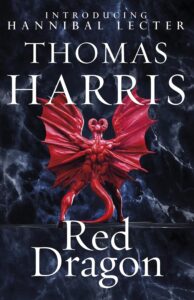
American Psycho
Another excellent jaunt inside the mind of a deranged killer. In part a black comedy, a commentary on consumerism and filled with gruesome imagery, this isn’t your typical crime novel. The reader sees the world so completely through the unreliable eyes of Patrick Bateman that as the novel progresses, it becomes harder and harder to untangle what is fact and what is fiction.
I’ll Be Gone in the Dark
This account of the hunt for the Golden State Killer is an absolutely riveting read, and made even more so by the fact that it’s a true story. Michelle McNamara’s tireless investigation makes for fascinating reading – albeit a bittersweet one at times; McNamara sadly passed away before the book was released, and just shortly before the Golden State Killer was caught.
The Five
Another factual book, The Five explores the legacy of the infamous Jack the Ripper – but focuses exclusively on his victims rather than the killer himself. It makes for a refreshing take, and I certainly found that almost all of my preconceptions about the victims were wrong in one way or another. It also discusses society’s fascination with serial killers, and whether this is ultimately a good thing or not.
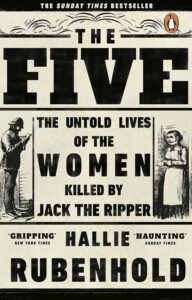
Sharp Objects
Whilst Gone Girl is the title that always comes up whenever people talk about Gillian Flynn, for me Sharp Objects is the better book. A journalist returns home to cover a series of murders and becomes embroiled with her family, the detective working the case and her own past. It’s an absolutely brilliant novel that keeps you guessing the whole way through.
Tell us about The Midnight King.
When it came to writing The Midnight King, I knew I wanted to write something dark and scary. What scares us changes as we grow older, however. I have two young children now, which I didn’t when I first started writing, and I realised that something happening to either of them was a new fear that I had unlocked. Exploring that felt like an obvious route to go down!
I also wanted to focus less on the traditional serial killer story and instead look at the legacy that a killer leaves behind. How it impacts on those around them – their family, their friends. What happens to those people once the killer is gone, and are their victims restricted only to the dead?
The Midnight King by Tariq Ashkanani is published by Viper, priced £16.99.
When whispers of abuse at Arrol’s department store reach Mabel, a determined policewoman, she knows she must act. Set against the backdrop of 1920s Glasgow, where women’s voices are often silenced, The Devil’s Draper weaves together crime, justice, and the fight for equality. We hope this extract whets the appetite to read on!
The Devil’s Draper
By Donna Moore
Published by Fly on the Wall Press
Johnnie wended her way through the well-dressed people chatting in small groups. She caught brief snatches of conversation as she passed: the happy couple were going to be honeymooning on the Riviera; the bride’s father had a fine stable of horses; had anyone else noticed the ghastly hat worn by Mrs Ellice… She took in the lie of the land, noting entrances and exits and places where staff were positioned, and then followed the steady stream of people entering the anteroom, where the wedding gifts were on display.
The embarrassment of riches weighing down the tables and floor of the anteroom took her aback and she came to a sudden halt just inside the door.
‘I say, m’dear, I’m terribly sorry.’ A red-faced gentleman had cannoned into her from behind. ‘You can’t just stop dead like that, ya know. I could have knocked you over and then where would we have been, hmm?’
‘I’m so sorry,’ Johnnie smiled at him and then turned her face quickly away, as if suddenly shy. She didn’t want him to recall her face later.
Johnnie sauntered around the tables, affecting an interest in the cards attached to the gifts. And it was a fine array of wedding gifts: a tortoiseshell and silver dressing table set from Colonel and the Honourable Mrs Ferguson; two Rockingham china figurines from Mr and Mrs William Brody; a silver plated inkstand and silver stamp box from the Misses Balfour; a rather ugly set of china jam pots from Mrs Ellice – presumably the same Mrs Ellice of the ghastly hat. Somebody had thoughtfully grouped the gifts into their different types, making Johnnie’s job easier, and her eyes lingered only briefly on the furniture, the paintings, the linens, the kitchenware and the eight heavy volumes of The War, bound in red cloth. Really, what had the Major McPhee who had given those been thinking? What would a newly married couple want with books about a war they doubtless wouldn’t want to be even reminded of, let alone read about it in eight volumes?
The books weren’t the only dud gift. Eglantine Cameron-Head – clearly a sworn enemy of the bride – had given the gift of an umbrella; the bridegroom was getting the reel for a trout rod from a Mr Brand; and a Mrs Denholm had for some reason thought that an old steel trivet was a welcome gift for the happy couple.
One area of the table caught Johnnie’s attention in particular.
Pretending to inspect a Liberty blotting pad and calendar, Johnnie glanced at the display of items to its right: a solid silver etui case, a diamond and sapphire pendant and earrings, a pair of matching gold watches, amethyst earrings, a set of gold and ruby shoe buckles, a rather fine-looking string of pearls and what looked like an antique diamond bracelet. Those and some other small pieces would do very nicely.
She glanced around the room. As well as the door through which she and the other guests had come, was another, less obtrusive, door at the far end. Probably one for the staff. If she wasn’t mistaken, this one would lead to one of the side staircases.
At that moment, a bell tinkled and the wedding breakfast was announced. Johnnie, along with the other guests in the anteroom, joined the rest of the party in the main room as they made their way to their seats.
Johnnie fluttered around as if trying to find her place, managing instead to find her way back to the anteroom door. She glanced quickly around. The guests were greeting their seatmates and the staff were all busy. Johnnie slipped inside the now empty anteroom once again. Her dress had been especially fashioned with numerous, carefully sewn pockets everywhere. However, Johnnie had a better idea. She picked up Eglantine Cameron-Head’s very thoughtful umbrella gift, unfurled it, swept all the jewellery from that end of the table into the folds of the umbrella, plucked two small, silver photo frames and a silver sugar shaker from their places, tucked them into two secure pockets in her wide sleeves, and exited the room via the small door at the far end.
She had been right. The corridor she was in led to a set of stairs and she tripped down them, smiling cheerfully at a young man on his way up, and left by the Woodside Crescent entrance. The weather had been overcast when she had entered the Grand Hotel and now it was raining. But the umbrella in Johnnie’s hand would need to stay furled.
The Devil’s Draper by Donna Moore is published by Fly on the Wall Press, priced £11.99.
Walk Like a Girl is a true story about a one woman’s journey to find herself and her place in the world. She hikes through Georgia, Nepal and India while dealing with personal heartbreak. Here is an extract from her time in Georgia.
Walk Like a Girl
By Claudia Esnouf
Published by Sparsile Books
If we were going to hitchhike, we had to do it properly. We headed to the nearest petrol station with our backpacks to find scrap pieces of cardboard and felt-tip pens to write out our destination. As I set out to write MESTIA, Andy caught my wrist.
‘Er, wait.’ He hesitated. ‘I think they write differently here.’
‘What do you mean? They’ll be able to read the same.’
‘No, I mean they have a different script. Squiggly letters.’
It took asking several different people before finding a man who could vaguely understand English. I watched as Andy tried to pry him for directions for Mestia. The man looked incredulously at us when he realised we were trying to hitchhike there.
I imagined two foreigners in Edinburgh asking someone if they could hitchhike on Princes Street. They’d probably be escorted to a holding cell.
Handily, he wrote out our destinations in Georgian on a piece of discarded cardboard. The Cyrillic script looked like a Comic Sans font from Microsoft Word. A few people lingered around the petrol station and watched us as we gathered our positions.
‘Great, now we have an audience,’ muttered Andy.
I clutched the piece of cardboard. We stood millimetres from the deafening highway; our bodies pressed against the dented road barriers that did little to protect us from the steep drop to the gorge below. Cars beeped, trucks blared their horns, people gestured out of their windows.
‘What do we do now?’ I yelled at Andy.
We could barely hear each other amidst the traffic racket.
‘Stick your thumb out.’
‘I mean, that’s pretty dodgy. It’s quite forward and a bit embarrassing, really. I don’t know, maybe we should just pay for a bus. We don’t even really know where we’re going.’
‘Stick your thumb out!’
‘Why don’t you do it?’
‘You’re a girl; they’ll pick us up faster.’
‘You mean you want them to pick me up in the hopes they can have sex with me?’
‘Antonia, just stick your fucking thumb out!’
—–
An hour later, we were standing in the same spot, puzzled at the lack of Georgian hospitality we’d read such great things about.
Our small audience watched us lazily, amused. A man sitting in his car across the road was looking at us, shaking his head and fingers, and I shot him a defiant glare. He sighed and waved his hands and then parked his car on the side of the highway. He quickly ran across the two large lanes towards us.
He was yelling at us in Georgian, and I backed into Andy, terrified we were somehow insulting him or his country. When he realised we spoke English, he exasperatedly tried to find the words.
‘No…No Mestia. Impossible!’ he said.
We argued, pointing at our maps and phones. It was possible, surely.
He wouldn’t even look at our maps. Andy realised that arguing in English was getting him nowhere and began gesticulating, pointing fingers and using some invented sign language.
Finally, the penny dropped.
‘I think he’s telling us we’re hitchhiking the wrong way,’ I said. I pointed to my right. ‘Mestia that way. Yes?’
‘Yes! Yes! Yes!’ He sounded delighted, patting us both on the back.
Sheepishly, we grabbed our bags and crossed the road.
I heard laughter and looked back, watching the audience at the gas station cheering. On the other side of the road, I stuck my thumb out again. In moments we were in a van, rattling away at the back.
—–
The hitchhike experience took us through the hills for hours on end. We sat in the back of a van where the men in the front sat drinking beer, then were squished in the back of a car where about eight family members were already sitting like sardines. A baby sat on my lap while another child held my hand without a word.
There was a father and son, where the son practised his English; and a lone lorry driver from Azerbaijan, who stopped at the side of the road and made us follow him up a hill so he could show us a holy cave.
Our last ride to Mestia was a car that seemed to date back to the sixteenth century. It looked like a patchwork quilt, made up of different parts and seemingly held together by string. It rattled up the hill, creaking around every precarious corner, cliffs plunging down for several kilometres into dark crevasses. We were driving up the Caucasus Mountains. I shut my eyes, but that made me more carsick, so I tried to focus on the broken road in front.
Andy wasn’t doing much better. The car was meant to fit five people at most, but we were nine, squished in and moving around every corner together. It felt like we were very slowly rumbling around Everest, past base camp and up to the peak.
Suddenly there was a huge bang. The driver yelled. The car screeched to a stop. We all gasped, lurching into focus. Our driver climbed out and after much screaming, people climbing out on top of each other, we managed to slide out and saw a huge rock that had fallen from the mountain and dented the car roof.
‘Lucky it wasn’t the windscreen,’ said Andy, who’d gone a further shade of white.
I gulped.
The driver, who seemed to have only just registered us all standing there, yelled at us to get back into the car, as he wiped his brow, issued a prayer and adjusted the wooden orthodox cross back onto the windscreen. Tension released and we heard nervous laughter. Some of the passengers clapped our backs, talking to us in fast, bubbly Georgian, and we nodded along in shock.
Walk Like a Girl by Claudia Esnouf is published by Sparsile Books, priced £10.99.









